INTRODUCTION BY DAVID HEY
Back in the day when life seemed so simple then, train spotting was the most popular hobby for boys, but make no mistake - train spotting was anything but simple!
During our frequent get togethers Jim regaled me with stories about his early train spotting days; he explained how he learned the intricacies of railway operations; he studied timetables and shed allocations, he read about inter-regional workings and the different steam loco classes, and then having familiarised himself  with the engines on his local line between Manchester and Liverpool - invariably spotting the same locos over and over again - it dawned on him that there were countless other engine numbers to be found further afield. So, there was nothing else for it. If he wanted to 'cop' his beloved Stanier Duchesses and Lizzies then the best place to go was Wigan North Western station, which was the nearest station on the West Coast Main LIne.
with the engines on his local line between Manchester and Liverpool - invariably spotting the same locos over and over again - it dawned on him that there were countless other engine numbers to be found further afield. So, there was nothing else for it. If he wanted to 'cop' his beloved Stanier Duchesses and Lizzies then the best place to go was Wigan North Western station, which was the nearest station on the West Coast Main LIne.
You see, Jim was just like the rest of us...train spotting mad! Most railwaymen were. It was a hobby that instilled honesty and integrity into everyone; that falsifying an entry in an Ian Allan abc books was futile because all you were doing was cheating on yourself!
We even tried our hand at railway photography, a natural adjunct to train spotting, and spurred on by the photos that appeared in the monthly railway magazines we snapped away with the simplest box cameras, hoping that one day our photos would be worthy of publication alongside such luminaries as Jim, who by then had become a regular contributor to 'Trains Illustrated' and 'Railway Magazine'.
But after steam finished in the late Sixties, steam enthusiasts became disillusioned with BR's so-called modern image; the 'box-like' appearance of diesels possessed nothing like the aesthetically pleasing shape of a steam locomotive and many boys lost interest in trains altogether.
However, in place of the old guard came a new generation of spotters to take up the challenge and so the fascination  for trains continued just as before. Indeed the rules of spotting have changed little over the years; it still embraces old-fashioned principles, established traditions, conventions and boundaries; all of which gave youngsters a semblance of meaning and more importantly, a grasp of their history. It also taught youngsters many valuable lessons about the 'real' world.
for trains continued just as before. Indeed the rules of spotting have changed little over the years; it still embraces old-fashioned principles, established traditions, conventions and boundaries; all of which gave youngsters a semblance of meaning and more importantly, a grasp of their history. It also taught youngsters many valuable lessons about the 'real' world.
But alas, the time comes in a spotter's life when their youthful innocence gives way to the chaotic world of adolescence and the hobby begins to lose its appeal after a while. All at once boys become more interested in pursuing more grown up things, like girls for instance - and very soon they're sliding down the slippery slope into matrimonial abyss and their lives are never the same again.
But there is a glimmer of light at the end of the day, because nostalgia becomes embedded in all of us at some point or other, and so when we look back on our childhood it is quite remarkable how our memories of spotting days are cherished above all others. Okay this might be regarded as passé by today's hoi polloi, but this is only because they have so few remarkable childhood memories of their own to speak of. 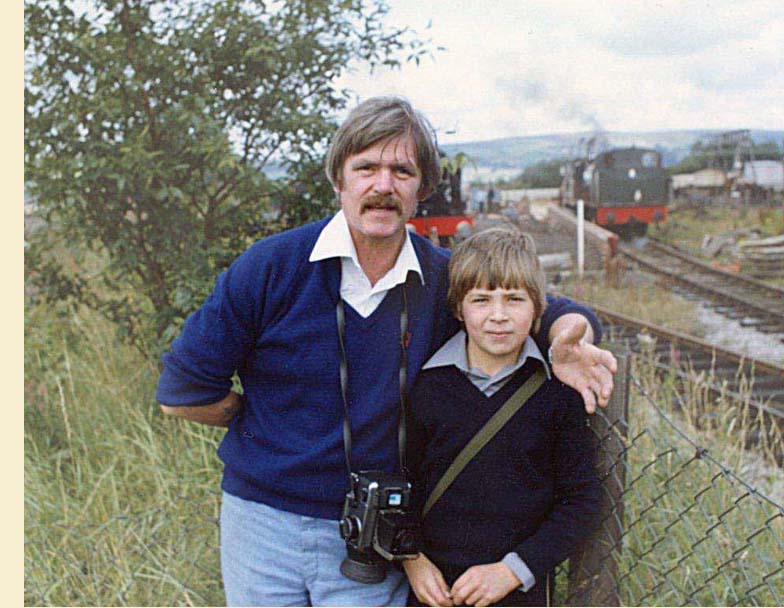 Whatever the reason, it doesn't matter if your allegiance is to steam or diesels I'm sure Chris's choice of photos will strike a chord...
Whatever the reason, it doesn't matter if your allegiance is to steam or diesels I'm sure Chris's choice of photos will strike a chord...
They do for me!
This is the second part of Chris's dedication to his dad - 'Footplate Cameraman', Jim Carter...
(Top Right) During a visit to the East Lancs Railway, Jim is ready to get down to the job at hand, in all probability photographing 'Leandor' - a full image appears at the bottom of the page. (Above Left) Jim and Chester driver, Brian Hickey, have a brew during a photographic trip to Southampton in May 1965. (Right) Dad and Chris on a lineside visit...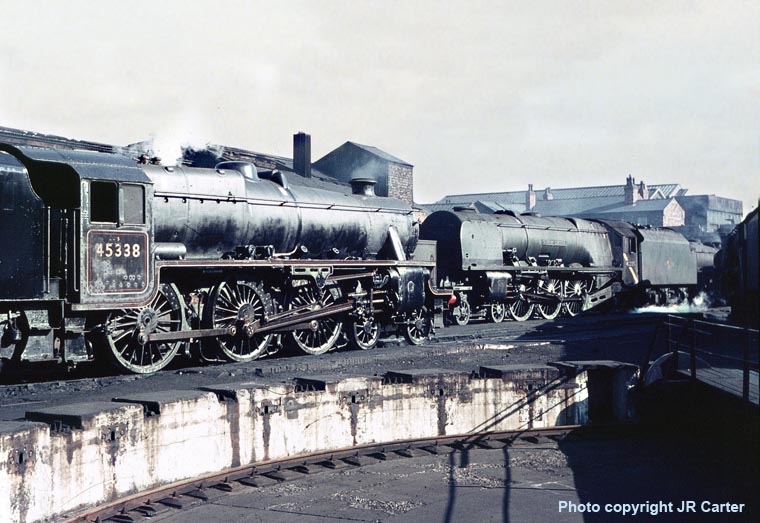
(Above-Below) A photograph very much of Jim's era - Crewe North shed during the early Sixties. Following the energisation of overhead catenaries on the West Coast Main Line south of Crewe (where the wires had been installed to clear 13ft 1ins loading gauge instead of the normal 13ft 6ins height gauge) diagonal yellow stripes were painted across the cabside of locomotives denoting their prohibition from working in electrified areas. The relaxation in clearance was permitted by the Minister of Transport to avoid the costly programme of rebuilding certain bridges and tunnels. Some of the classes prohibited included: 'Royal Scots'; 'Patriots'; 'Jubilees'; Class 4F, 7Fs and 'Coronation' Pacifics which carried the compulsory cabside stripe. The engines permitted to work in electrifies areas had their smokebox door lamp bracket moved to a lower position to prevent locomen climbing up to chimney height in the vicinity of the 25kV overhead wires. The official ban south of Crewe began on September 1st 1964. Jim photographed Black 5 No 45338 and 'Duchess' 46239 City of Chester (sporting the diagonal stripe on the cabside) awaiting their next turn of duty at Crewe North shed. (Below) Jim was one of Britain's favourite railway photographers; an all-weather man who braved the Arctic conditions on the Standedge route across the Pennines to capture some classic snowscenes...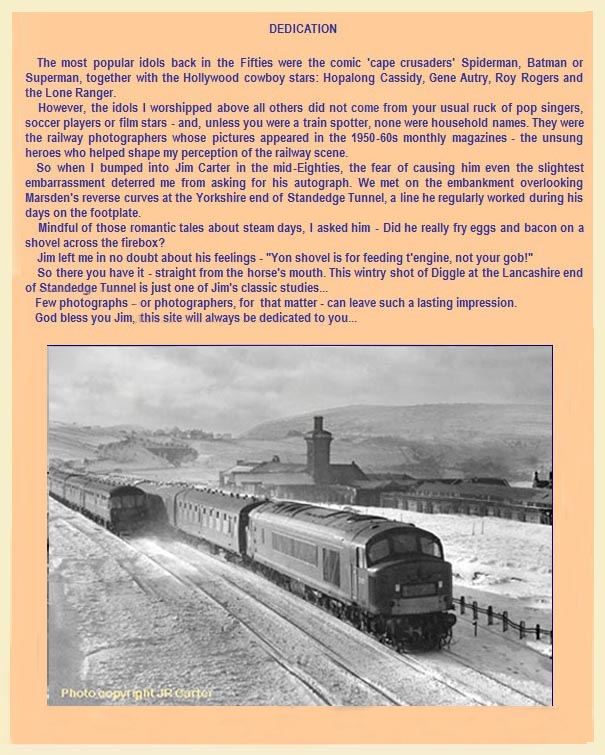
CHRIS TALKS ABOUT HIS DAD's MEMORIES OF STEAM DAYS
As David mentions above, there was a time when train spotting was the national hobby for boys, and this was certainly the case for the vast majority of railwaymen. So it comes as no surprise that dad was an ardent spotter from a very early age. He was often accompanied by his younger brother, my Uncle Colin, and the highlight of the week for the two of them was a Saturday as it gave them the chance to spend the day at 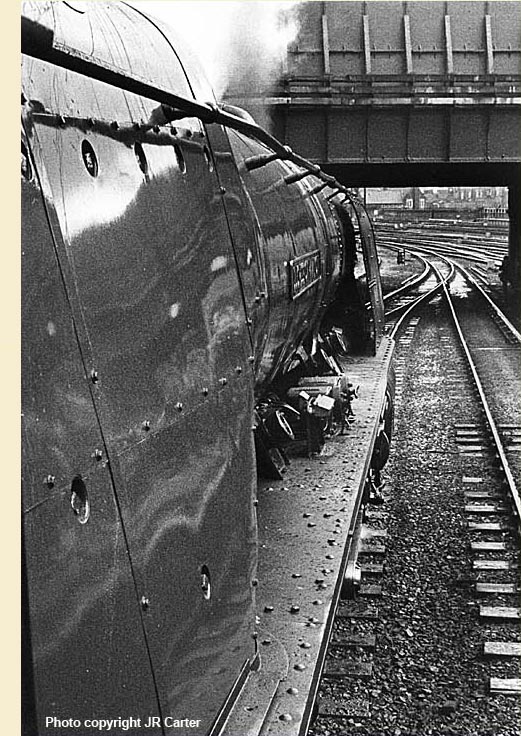 Wigan North Western station where they could spot the Anglo-Scottish expresses on the West Coast Main Line. It was during those early spotting days that dad's association with the Stanier Pacifics really began. The sight of a gleaming 'Duchess' No 46245 City of London approaching the station on the 50mph curve with the northbound 'Royal Scot', and then being opened up to tackle the incline north of Wigan was an experience that left a lasting impression on him.
Wigan North Western station where they could spot the Anglo-Scottish expresses on the West Coast Main Line. It was during those early spotting days that dad's association with the Stanier Pacifics really began. The sight of a gleaming 'Duchess' No 46245 City of London approaching the station on the 50mph curve with the northbound 'Royal Scot', and then being opened up to tackle the incline north of Wigan was an experience that left a lasting impression on him.
Many years later, however, and dad got the chance to drive a 'Duchess' for the very first time at Wigan North Western station. It happened during engineering diversions on the West Coast Main Line due to electrification work between Wigan and Crewe. Dad was booked to fire a 'Super D' with the regular driver Joe Fletcher on the Ship Canal shunt that day, when the Running Foreman said he was taking him off for another job. So after travelling 'pass' to Wigan and reporting in to Control, dad was told that he'd be acting as a pilot driver from Wigan to London Road station in Manchester.
As he walked down the platform to meet his train, he had a massive surprise in store when 'Duchess' class No 46257 City of Salford drew to a halt on a Glasgow-Euston express. The driver wasted no time retiring into the first coach with his brew can - and, dad being an eager-beaver, didn't waste any time climbing onto the footplate either...
Waiting for him was the fireman, himself a passed man with considerable experience and some ten years older, but as he was unfamiliar with the route between Wigan and Manchester via Tyldesley, dad's route knowledge took priority over seniority.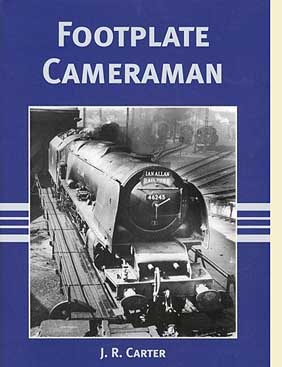 I can easily imagine what a 'Duchess' fanatic like dad must have felt being at the regulator of a Stanier Pacific for the first time. Since he was a lad it had always had his ambition to drive a 'Duchess', and although he had many more turns on 'Duchesses' between Wigan and Manchester during engineering diversions, nothing compared with the feeling of that first trip.
I can easily imagine what a 'Duchess' fanatic like dad must have felt being at the regulator of a Stanier Pacific for the first time. Since he was a lad it had always had his ambition to drive a 'Duchess', and although he had many more turns on 'Duchesses' between Wigan and Manchester during engineering diversions, nothing compared with the feeling of that first trip.
He recalls passing the shunters' cabin at Stott Lane, where Joe Fletcher was sitting outside having his scoff with the other shunters. They all looked up in disbelief when dad gave a victorious toot on the whistle as the 'Duchess' roared past! He even managed to take a shot from the driver's seat (above) during a signal check at Ordsall Lane, Salford.
But all good things must come to an end, and after arriving at Manchester London Road the booked driver was back on 46257 for the journey south, and reality beckoned for dad the very next day when he found himself back firing a 'Super D' with Joe Fletcher on the Ship Canal shunt...'
(Above Left-Below) Dad's pictorial railway book 'Footplate Cameraman' was first published in 1983 by Ian Allan Ltd and featured a typical shot of a Stanier 'Duchess' class Pacific on the turntable at Crewe North. The same photo was used for the cover of a second edition published by Heathfield Railway Publications in 2009. (Below) It's well known that dad's favourite locos were the 'Duchesses' whilst Crewe North (5A) his favourite location, and so it came as no surprise to me that he took more than one shot of 46245 on the turntable...

(Above) The Southern Railway was the most progressive of the 'Big Four' railway companies prior to nationalisation. Having invested heavily in 3rd rail electrification during the 1930s, the SR's Chief Mechanical Engineer, OV Bulleid, had plenty of experience with small-wheel multiple unit motor bogies, but was looking at diesel-electric traction as an alternative to costly third-rail electrification on some west of England routes. The result was the SR/EE Co diesel electric No 10201, built at Ashford works in 1950. 10201's power unit was the same 16-cylinder 16SVT engine as fitted to the earlier LMS Co-Cos, but the loco was equipped with the EE Napier 75100 Turbocharger, which produced a more powerful 1,750hp.
(Below) The second SR/English Electric 1,750hp ICo-Co1 No 10202 entered traffic in August 1951. Because of the bulky medium-speed engines and electronic plant then available, the SR diesels had to be mounted on 1Co-Co1 bogies, which were made up of three motored wheel sets and an outer non-powered guiding axle to distribute the weight. The longer wheelbase was designed by OV Bulleid to meet the requirments of the SR's Chief Civil engineer, who wanted to spread the axle load and reduce excessive rail wear. When the new pilot scheme diesel locomotives were ordered by the BTC in 1955, BR's Civil Engineers shared the same anxieties, and strict stipulations were put in place to limit wheel diameter in relation to axleload which led to the cumbersome 1Co-Co1 bogies on the EE Type 4 D200s and the BR/Sulzer 'Peaks'. In 1955 the SR trio was appropriated by the London Midland Region for evaluation against the earlier Co-Cos Nos 10000/1, but the performance of the diesels were impaired by the dire conditions under which they were kept. This view of Crewe South shed shows fitters on the roof of No 10202 (in original black livery) at Crewe South (5B) in 1955. 
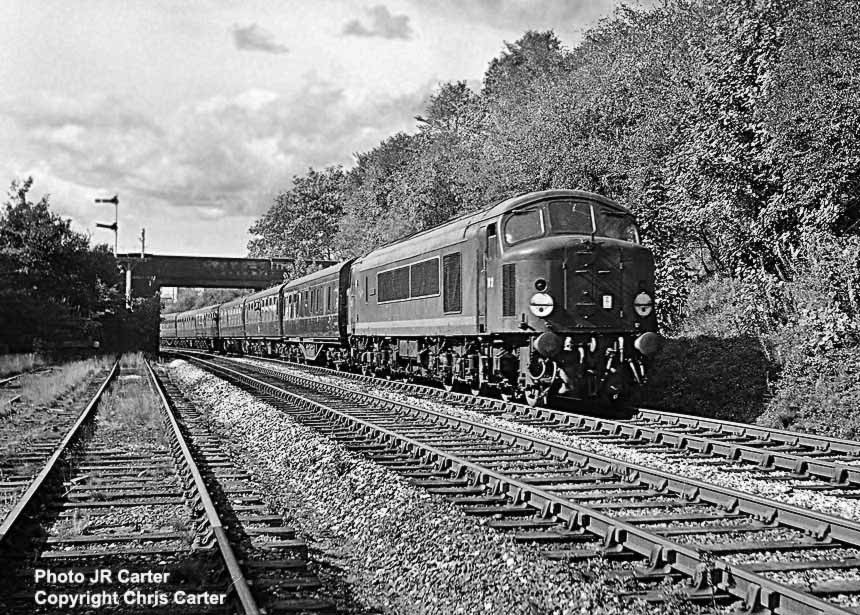
(Above) In the BTC's 1955 Modernisation Plan, the headlong rush to eliminate steam in favour of modern diesel and electric traction led to several orders being placed with the manufacturers before the new pilot scheme designs had been fully evaluated in service conditions. The BR works at Derby was responsible for building the pilot scheme BR/Sulzer 2,300hp 1Co-Co1 Nos D1-D10 in 1959. The 10 Type 4 'Peak' locomotives were extremely heavy, turning the scale at more than 138 tons working weight which necessitated the use of the cumbersome 1Co-Co1 wheel arrangement in order to distribute the load. The Peaks had the dubious distinction of being the heaviest, yet they had a neat appearance - the nose-end closely resembling that of the LMS pioneers No 10000/1 into which gangway doors were provided. All ten locomotives (Class 44) were named after Welsh or English mountains, and the name 'Peaks' was subsequently dubbed on the production models, 127 of which were ordered before the first pilot scheme batch had actually been completed. Nos D1 to D10 were allocated initially to Crewe. Jim photographed No D2 Helvellyn passing Worsley, Manchester, with a diverted Glasgow-Euston express due to electrification work on the WCML south of Wigan. 
(Above-Below) The ten pilot scheme 'Peaks' were followed by 183 production locomotives Nos D11-D193, all built at Crewe and Derby to the same basic design, but equipped with the more powerful Sulzer 12LDA28 'B' engine uprated to 2,500hp. Later to become known as Class 45, Nos D11-D137 were fitted with Crompton Parkinson electrical equipment, and Nos D138-D193 (later Class 46) had Brush electrical equipment instead. Crewe Works was responsible for building Nos D50-D137 in the fleet (Class 45s) including D101 seen here outside the Paintshop. No D101 (later Class 45 45061) was withdrawn from traffic in August 1981 and scrapped at BREL Swindon in April the following year. (Below) This famous shot by Jim shows a newly-built 'Peak' undergoing steam heat boiler tests outside the paintshop. In the background black smoke from a 'Scot' class adds considerably to the picture.
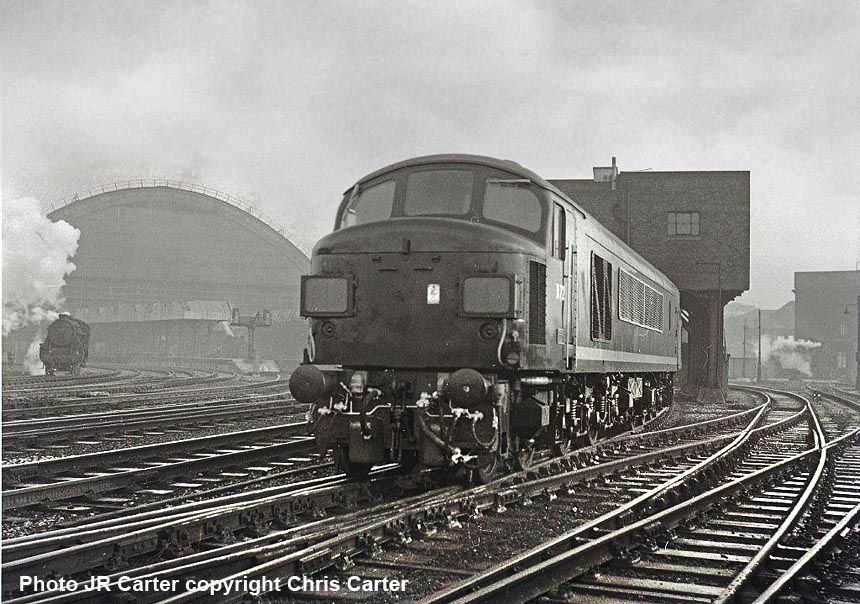
(Above) Although the production Peaks were similar in appearance to the pilot scheme machines, some front end variations were incorporated when the gangway doors and white headcode discs were abandoned in favour of divided headcode boxes - one each side of the nose on Nos D11-31 and D68-107 - and a two-piece or solid route indicator panel  centrally placed on the remaining locomotives. When Andy Sparks, editor of the CFPS's 'Whistler' magazine was emailed this shot of D72, he replied - 'A brand new 'Split Box Peak' at Manchester Central...now a popular Exhibition Centre and Meeting venue, where both the Conservative and Labour Parties Annual Conferences have been held. It is quite rare to see photos taken at Central. I wonder if Chris will unearth one showing the 'Midland Pullman'. This train ran between Manchester Central and St Pancras during the mid-1960s. The 'Peak' would have been waiting its next turn of duty on a Manchester-St Pancras train via the ex-Midland main line to Derby. It might even have been on test from the works there...'
centrally placed on the remaining locomotives. When Andy Sparks, editor of the CFPS's 'Whistler' magazine was emailed this shot of D72, he replied - 'A brand new 'Split Box Peak' at Manchester Central...now a popular Exhibition Centre and Meeting venue, where both the Conservative and Labour Parties Annual Conferences have been held. It is quite rare to see photos taken at Central. I wonder if Chris will unearth one showing the 'Midland Pullman'. This train ran between Manchester Central and St Pancras during the mid-1960s. The 'Peak' would have been waiting its next turn of duty on a Manchester-St Pancras train via the ex-Midland main line to Derby. It might even have been on test from the works there...'
(Below) Well, Chris did manage to dig out one of his dad's negatives of the Blue Pullman. When the service started on July 4th 1960, the blue riband for Britain's fastest passenger train went to the London Midland Region's Central Line. As it turned out, the Midland Pullman was not far removed from the HST consisting of two six-coach sets with streamlined power cars, two kitchen cars and two parlour cars, providing 132 1st class seats. Surprisingly, the traditional umber and cream livery of previous Pullman stock was not adopted. Instead, the new Pullman was painted in a striking Nanking blue and white livery with the fine fuedal Pullman coat of arms applied to the nose ends. The luxury trains were air-conditioned, sound proofed and thermally insulated, with double glazed windows and wall-to-wall carpeting in the traditional Pullman style of open saloons, which included airline-style seats and fixed tables. The prestigious Midland Pullman service left Manchester Central at 8.50 and completed the 190 miles to St Pancras in 194 minutes, including a stop at Cheadle Heath. Following completion of WCML electrification, an entirely new passenger service came into operation between Manchester Picadilly and Euston - the fastest train taking only 2hrs 35 minutes for the 189 miles at an average speed of 73mph. By March 1967 the Midland Pullman was rendered surplus to requirments and the two 6-car sets joined the Western Region's three 8-car sets for use on the Paddington-Bristol and Paddington-Wolverhampton routes.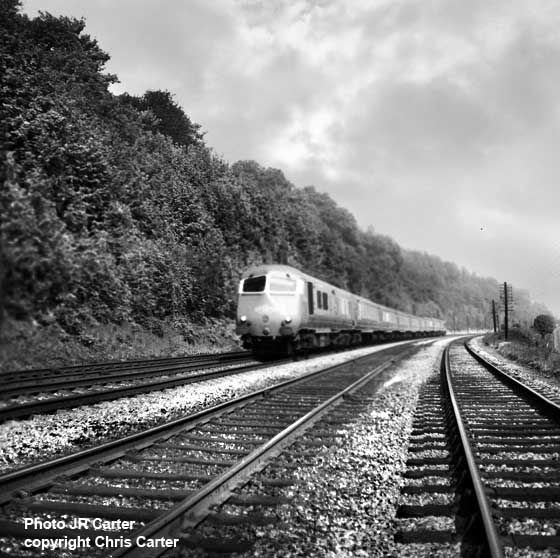
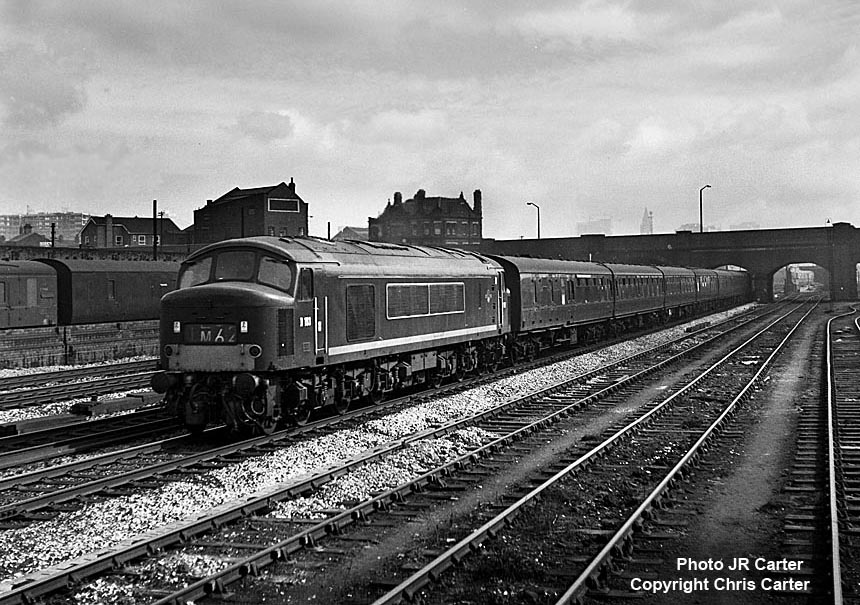
(Above) The bodyside detail shows up well in Jim's shot of 'Peak' class D185 (TOPS Class 46 46048) heading the 08.42 Newcastle-Liverpool express past Ordsall Road Carriage Sidings.
In 1961, British Railways abandoned the aged 'disc' display system (a legacy of steam days) in favour of a new four-character letter and numeral headcode display. The train classification, destination and identification system was introduced to assist signalmen in identifying trains. The headcodes consisted of a four-character display; the first numeral identifying the class of train, followed by a letter indicating the destination, whilst the next two digits represented the train reporting number. For example, a headcode display starting with a '1' denoted an Express passenger or mail, breakdown train en route to a job; '2' Ordinary passenger train or breakdown train not en route to a job; '3' Express parcels permitted to run at 90 mph or more; '4' Freightliner, parcels or express freight permitted to run at over 70 mph; '5' Empty coaching stock; '6' Fully fitted block working, express freight, parcels or milk train with max speed 60 mph; '7' Express freight, 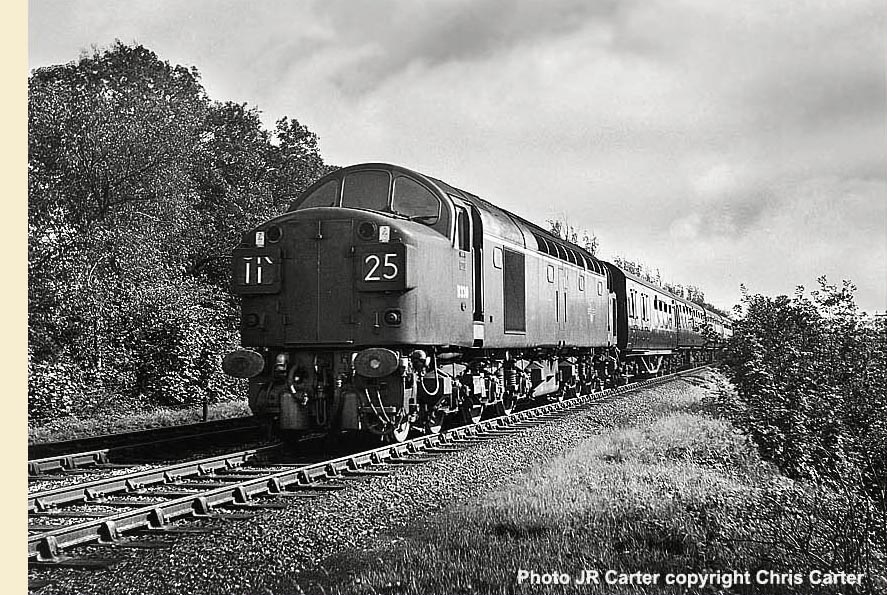 partially fitted with max speed of 45 mph; '8' Freight partially fitted max speed 45 mph; '9' Unfitted freight (requires authorisation) engineers train which might be required to stop in section and '0' Light engine with or without brake van. The second character indicated the destination. The BR Regions each had their own codes but inter-Regional trains used following letters: 'E' Eastern Region; 'M' London Midland Region; 'N' for the short-lived North Eastern Region which amalgamated with the Eastern Region in 1967; 'O' Southern Region; 'S' Scottish Region and 'V' Western Region. The last two numbers identified the actual working.
partially fitted with max speed of 45 mph; '8' Freight partially fitted max speed 45 mph; '9' Unfitted freight (requires authorisation) engineers train which might be required to stop in section and '0' Light engine with or without brake van. The second character indicated the destination. The BR Regions each had their own codes but inter-Regional trains used following letters: 'E' Eastern Region; 'M' London Midland Region; 'N' for the short-lived North Eastern Region which amalgamated with the Eastern Region in 1967; 'O' Southern Region; 'S' Scottish Region and 'V' Western Region. The last two numbers identified the actual working.
(Above Right - Below) The headcode panels were a great aid for identifying trains, but over the years vibrations caused the numbers to revolve on their own accord, and the varying non-descriptive digits that appeared was a major factor for BR's decision to dispense with headcodes entirely. Here EE Type 4 No D330 should be displaying 1L25 - identifying the 10.38 Euston-Carlisle with a Windermere portion. In the 1961 winter timetable it was the 10.25 ex-Euston. (Below) The centre headcode panel of 'Peak' class D193 (TOPS Class 46 No 46056) also displays a disjointed configeration 1N 80 - 11.00 Liverpool Lime Street-Scarborough - while in the background, a Swindon-built Trans-Pennine (TOPS Class 124) InterCity unit heads towards Liverpool. The 124 units were a stylish addition to the BR fleet and began srvice on January 2nd 1961 between Hull and Liverpool, with 6 trains each way daily via the Standedge route. Their power/weight ratio made possible substantial acceleration of the Trans-Pennine service. 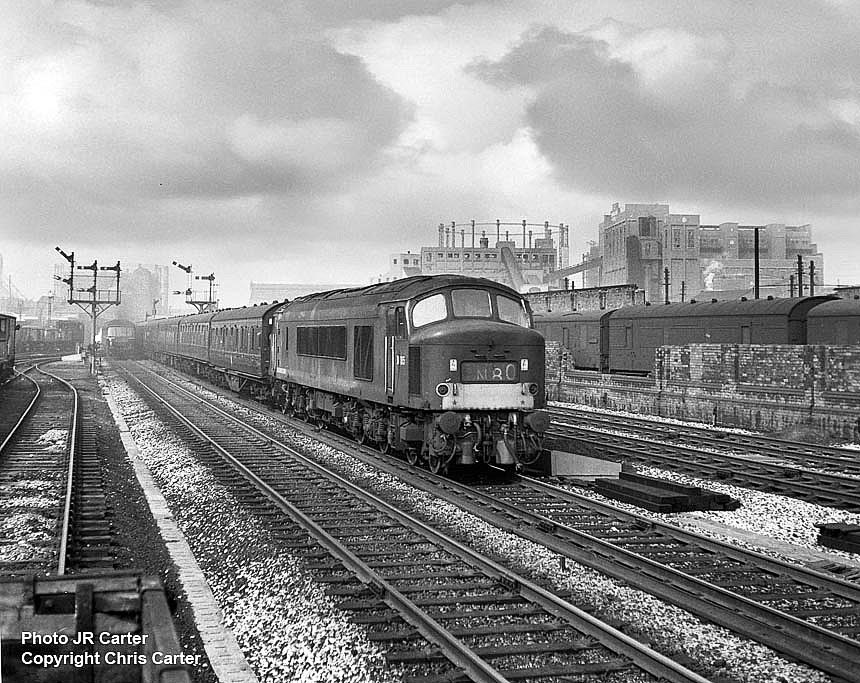

(Above) In its smart, but unorthodox light blue, grey and yellow striped livery, the EE Co's prototype 'Deltic' (DP1) makes a fine sight heading a Liverpool-Euston train. As the LMR was proposing electrification of the West Coast Main Line, the prototype Deltic was transferred to the East Coast Main Line based at Hornsey, for having been denied ECML electrification, the Eastern Region urgently needed a more powerful unit to substitute its fleet of EE Type 4 2,000hp diesels.
Having moved to Patricroft in March 1959, dad spent the next three years progressing through most of the links, gathering valuable experience all the way. In August 1962 he became a passed fireman which meant that he could be called upon to drive steam locomotives and it was just a matter of time before he became a regular engine driver.
During this time dad had many more conducted turns on 'Scots' and 'Duchesses', but the diesels were making major inroads into steam diagrams. Late one evening dad and his mate had booked on at Patricroft as usual and worked a train to Wigan North Western. After leaving the engine at Springs Branch shed they were just about to return to their home depot when they were asked to conduct a Perth-Euston sleeper from North Western station to Manchester London Road.
Expecting to see a 'Duchess' on the front, dad was surprised to see what he thought was a 'Deltic'. The motive power was none other than the experimental English Electric loco DP2, complete with white-coated technicians, however they wouldn't let dad's mate drive because he had not been trained; instead he had to instruct the driver who had brought her in...
(Below) After five years into the 1955 Modernisation Plan, the British Transport Commission (BTC) began seeking a new single-engined Type 4 of more than 2,500hp, which could be mounted on a Co-Co wheel arrangement. This followed criticism of the poor power/weight ratio of the earlier 1Co-Co1 Type 4 locos ordered under the modernisation scheme. The English Electric's candidate for the new Type 4 was DP2 - Diesel Prototype 2 - which emerged from the EE Co Vulcan Foundry in May 1962. The loco appeared in Deltic-style bodywork, as savings on production costs could be made by using existing materials. The prototype began trials on the LMR based at Camden shed and passed its first year on a diagram covering a remarkable 3,600 miles per week.

(Above) The fleet of 2,750hp Class 50s Nos D400-D449, were the production development of the EE Co's prototype DP2, and made their debut in 1967 as a stop gap for the WCML pending completion of the 25kV electrification between Weaver Junction and Glasgow. Dubbed 'Hoovers' by enthusiasts (due to the arrangement of the air intake fans which produced a rather distinctive sound) Jim photographed 448 heading the 09.50 Manchester-Preston through the Salford curves in August 1974.
The train combined with the 09.53 ex-Liverpool Excgange at Preston to go forward to  Glasgow/Edinburgh. The loco (later TOPS Class 50 No 50048 is sporting its overall rail blue livery with full yellow ends; black bufferbeam, bogies and undergear, together with the barbed-wire logo (indicating two-way traffic) which the BRB adopted in place of the British lion and wheel symbol. It wasn't until after the Class 50 fleet was transferred to the Western Region in late 1972 that a startling new BR standard livery was applied complete with large white symbol and numerals on the bodyside...
Glasgow/Edinburgh. The loco (later TOPS Class 50 No 50048 is sporting its overall rail blue livery with full yellow ends; black bufferbeam, bogies and undergear, together with the barbed-wire logo (indicating two-way traffic) which the BRB adopted in place of the British lion and wheel symbol. It wasn't until after the Class 50 fleet was transferred to the Western Region in late 1972 that a startling new BR standard livery was applied complete with large white symbol and numerals on the bodyside...
(Below) Returning to the Sixties, having been awarded the contract for the new BR Type 4, the first Brush 2,750hp machine D1500 rolled off the company's production line early in  September 1962 for acceptance trials. As the Brush Works at Loughborough was unable to build sufficient numbers of the new Type 4 to meet delivery targets, an agreement was made with BR for Crewe workshops to construct some of the locomotives under licence. Conditional paths were made available between Crewe and Carlisle for testing new diesels built either at Crewe or the English Electric Co works at Newton-le-Willows, and Crewe-built Brush Type 4 No D1815 displays 1T94 in its four panel route indicator as it heads the test train south through Carnforth on the return leg to Crewe.
September 1962 for acceptance trials. As the Brush Works at Loughborough was unable to build sufficient numbers of the new Type 4 to meet delivery targets, an agreement was made with BR for Crewe workshops to construct some of the locomotives under licence. Conditional paths were made available between Crewe and Carlisle for testing new diesels built either at Crewe or the English Electric Co works at Newton-le-Willows, and Crewe-built Brush Type 4 No D1815 displays 1T94 in its four panel route indicator as it heads the test train south through Carnforth on the return leg to Crewe.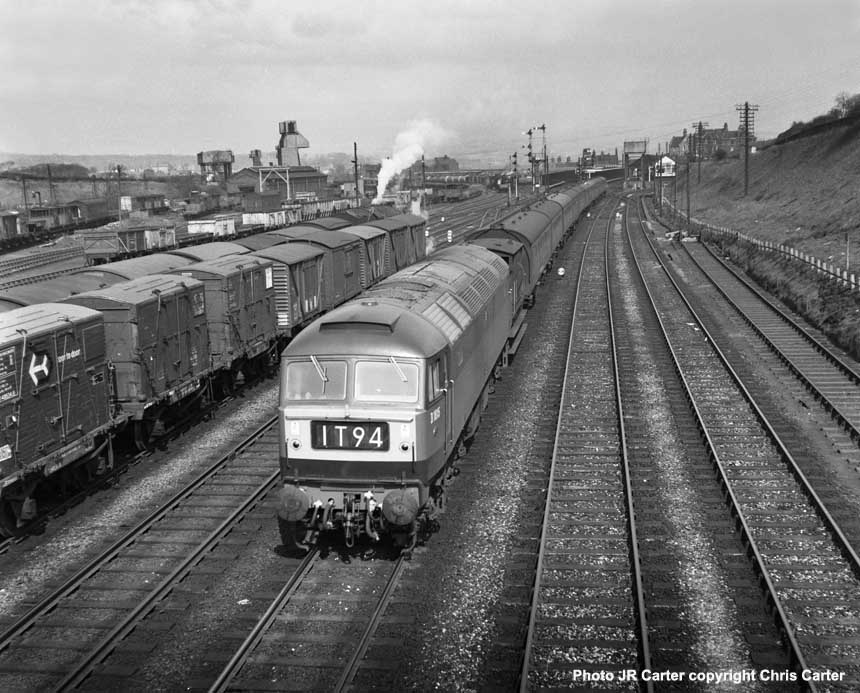
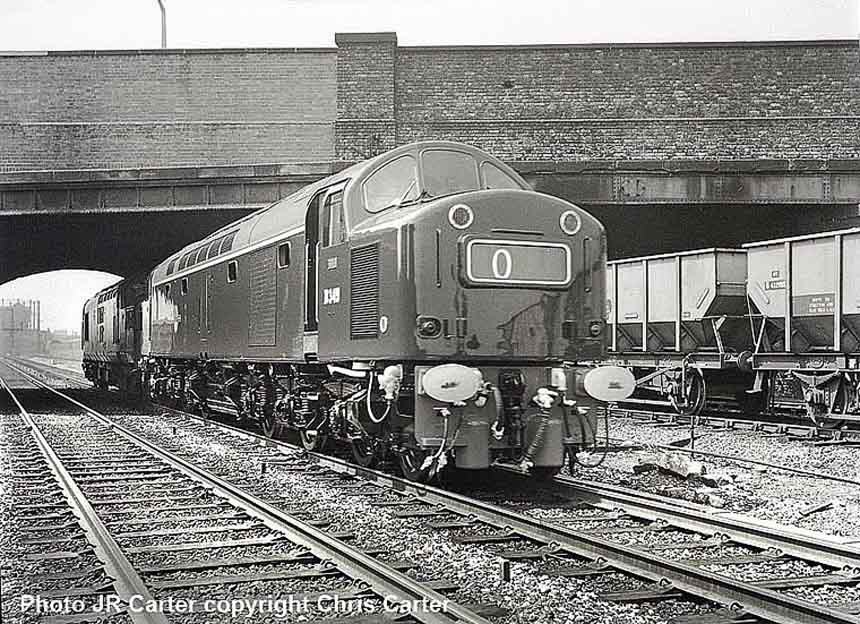
(Above) The final batch of EE Type 4s Nos D345-D399 was fitted with a single-four-character headcode panel centrally placed. The first twelve members were allocated to the North Eastern Region between May and August 1961, including the celebrity locomotive No D345, (later TOPS class 40145) which was sent new to Neville Hill shed Leeds. Following withdrawal in May 1983 after 22 years of service, 40145 was given a new lease of life under the auspices of the Class Forty Preservation Society on the East Lancashire Railway based at Bury. Here we see yet another classic shot by Jim of a delivery run from the EE Co works at Newton-le-Willows to Doncaster Plant  for acceptance trials, this time No D349 is paired with an unidentified Type 3 as they pass Ordsall Lane Sidings Manchester
for acceptance trials, this time No D349 is paired with an unidentified Type 3 as they pass Ordsall Lane Sidings Manchester
(Left) Compared to the pristine condition of the EE machines above, within a few weeks of service No D276 has already acquired a generous coating of grime which has eradicated any semblance of a locomotive livery. Many factors can contribute to the general discolouration of paintwork, notably the inorganic dust originating from brake shoes which can spread itself as an even layer from rail level upwards.
(Below) A famous headcode - 1S57 northbound 'Queen of Scots' - is displayed in the route indicator panel of Peak class No D170 (later TOPS Class 46 No 46033) as it approaches Wortley South Junction. The train is made up of an almost uniform rake of the new Metro-Cammel Pullman cars, first introduced on the London-Sheffield 'Master Cutler' Pullman in September 1960. They appeared on the'Yorkshire Pullman' and 'Tees-Tyne' Pullman duties in January the following year. The 44 vehicles were used entirely on the East Coast main line services, but as no Pullman brake cars were built in the same order, the elderly flat-sided Pullman brakes were utilised, in this case situated the third vehicle from the front. With the introduction of more modern coaching stock fitted with electric train heating (ETH) - the original train heating boilers and water filling point were removed from cantrail height to prevent crewmen climbing up to roof level in areas with overhead electrification equipment. The 3 bodyside steps were subsequently plated over.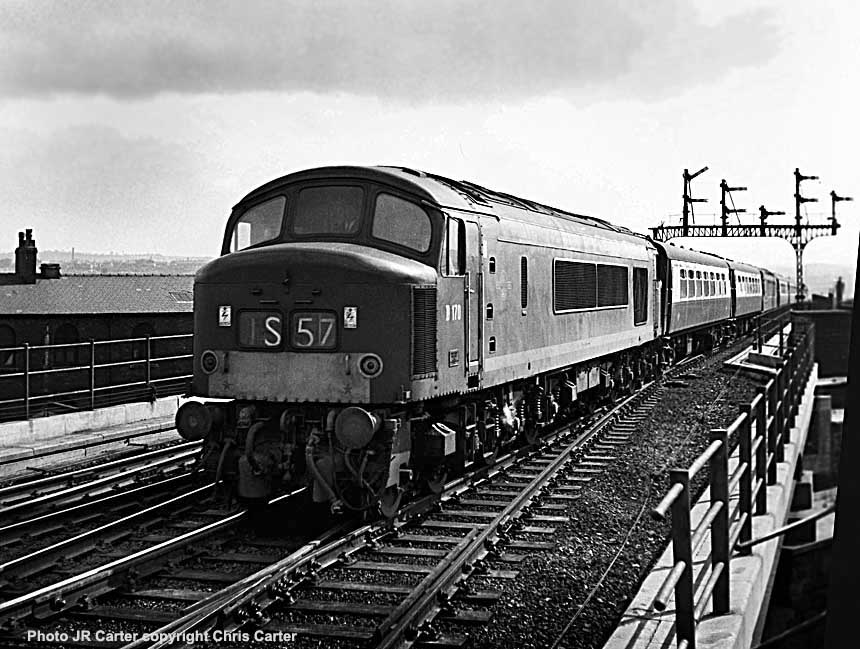
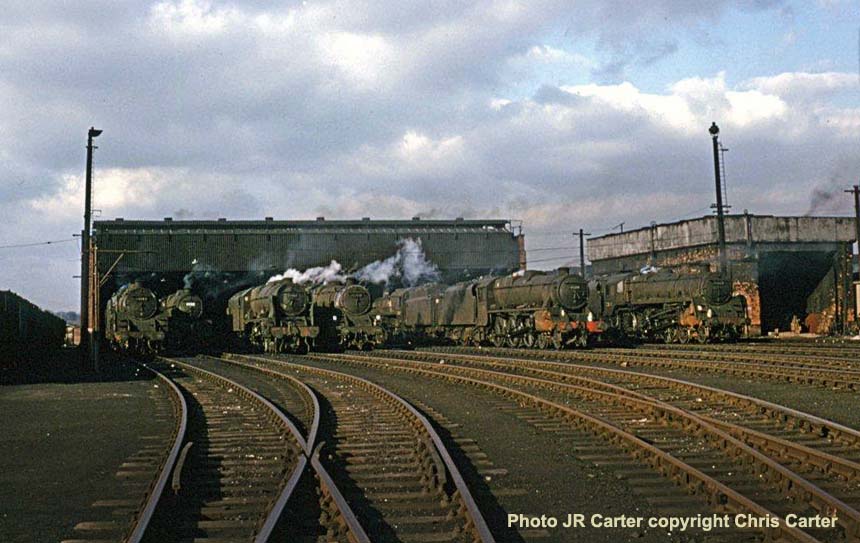
(Above-Below Right) A line up of various steam classes at Patricroft (26F). (Below) A typical elevated JRC view of Speakmans Sidings at Tydesley on the Manchester-Wigan line. An unusually clean Class 8F is caught in the evening sunshine. 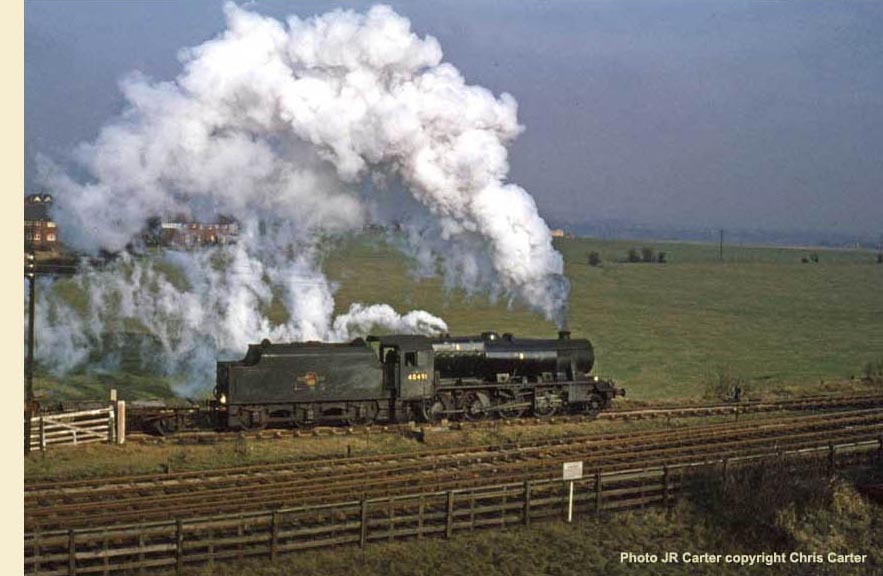 As the withdrawal of steam gathered pace during the Sixties, many Motive Power Depots, including Patricroft, were saddled with rows of redundant locomotives placed in store, their chimneys bagged up waiting to be quietly dragged away for scrap. Some locos were scrapped in ex-works condition while others were considered surplus to requirements at less than seven years old, despite having many years of life left in them.
As the withdrawal of steam gathered pace during the Sixties, many Motive Power Depots, including Patricroft, were saddled with rows of redundant locomotives placed in store, their chimneys bagged up waiting to be quietly dragged away for scrap. Some locos were scrapped in ex-works condition while others were considered surplus to requirements at less than seven years old, despite having many years of life left in them.
But then dad was under no illusion about the advantages of modern traction. When he worked the Manchester-Llandudno turn during steam days he recalls the rigmarole in preparing the steam locomotive for the return journey - 'It was a completely different story with a Type 4 - no turntable operation, no dragging coal down, no wrestling with the 'bag' or struggling with the fire irons. With a Type 4, it was just a matter of brewing up, changing ends, running-around and right-away...'
Gradually, after a few more trips manning the Type 4s, they began to grow on him and it wasn't long before his camera rejoined the contents of his bag to accompany him in the cab.
Looking through dad's collection of railway photographs, his celebrated multi-flash night scenes stand out a mile! Being a railwayman he was in a privileged position and able to enjoy opportunities only open to railwaymen, and so whenever he had a quiet shift at Patricroft, and there was no shunting work to do, he'd move an engine into place and set about planning various photographic compositions, but not before first cleaning the side of the loco that he wanted to photograph, perhaps taking two hours or more using oily rags and cotton waste.
Then after throwing a round of coal across the box to improve the appearance of smoke against the dark night sky, he positioned the camera on a tripod and placed the flash bulbs in the required positions alongside the engine, and at the front and back. Then after  pressing 'Brief Time' on the shutter he would walk around the loco firing the small hand held PF1 flash bulbs, while the shutter of the camera remained open during the time exposure. Dad's nocturnal shots have been published many times before, though not this one...he was a perfectionist, but I just know he would crack a smile at its inclusion, since so many of his photos were cropped to avoid his ghostly image showing up during momentarily pauses to fire off flash bulbs at the engine!
pressing 'Brief Time' on the shutter he would walk around the loco firing the small hand held PF1 flash bulbs, while the shutter of the camera remained open during the time exposure. Dad's nocturnal shots have been published many times before, though not this one...he was a perfectionist, but I just know he would crack a smile at its inclusion, since so many of his photos were cropped to avoid his ghostly image showing up during momentarily pauses to fire off flash bulbs at the engine!
(Above-Below) Back in the 1960s, the modern diesels and old-fashioned steam never did make happy bedfellows. This is clearly illustrated in Jim's shot of EE Type 4 D336 in the shed yard at Patricroft Loco. (Below) 'Black 5' No 44819 gets the 'special' Carter treatment at Patricroft...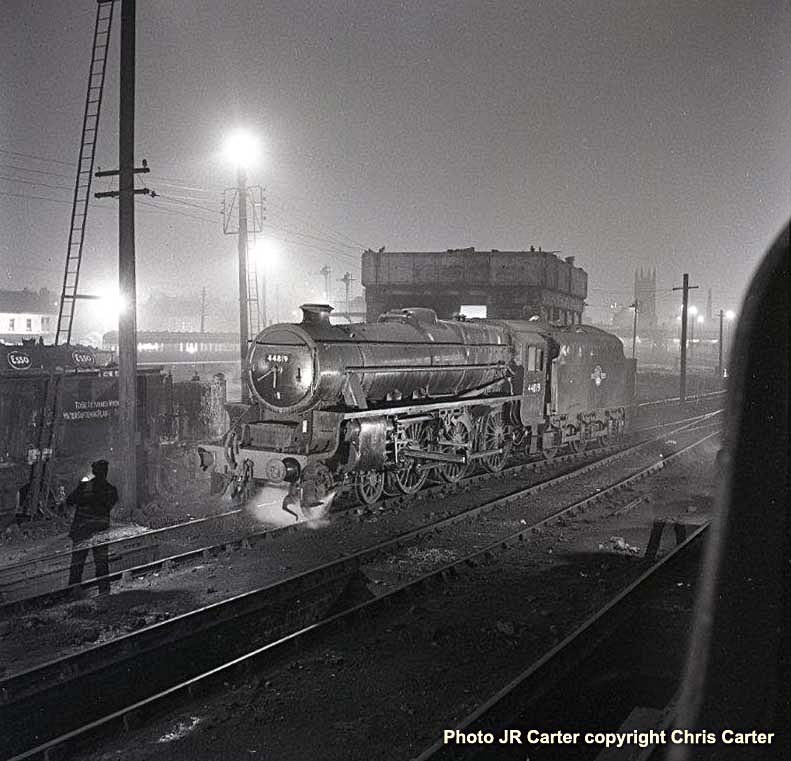

(Above-Right) The 'Britannia' Class 7MT Pacific was a straightforward 2-cylinder design, and probably more of an amalgam of former companies engines than any other BR Standard types built. Due to their relatively recent construction (early to mid-Fifties) they were among the last survivors of WCML steam based at Carlisle Kingmoor before the shed closed its door to steam on January 1st 1968. No fewer than 13 engines survived up to the December deadline, including the now-preserved No 70013 Oliver Cromwell seen here being turned at Patricroft shed...this photo bears all the  hallmarks of a JRC composition. Indeed Jim's elevated shots of Patricroft turntable take railway photography to a whole new level...quite literally, since he clambered to the somewhat 'hairy' heights of the coal shute (inset right) which gave him a grandstand view of the goings on in the shed yard. Here the coaling tower dominates 'Black 5' No 45156 Ayrshire Yeomanry, a favourite Patricroft loco that was frequently used on railtours during the final days of steam.
hallmarks of a JRC composition. Indeed Jim's elevated shots of Patricroft turntable take railway photography to a whole new level...quite literally, since he clambered to the somewhat 'hairy' heights of the coal shute (inset right) which gave him a grandstand view of the goings on in the shed yard. Here the coaling tower dominates 'Black 5' No 45156 Ayrshire Yeomanry, a favourite Patricroft loco that was frequently used on railtours during the final days of steam.
Dad spent a total of 27 years in the footplate grade and eventually achieved his ambition to become a main line driver, however the BR 7MT 'Britannias' were not one of his favourite classes. He was always more comfortable with the Stanier cab.
He told me about the time he was waiting with his driver at Chester General to relieve the Holyhead crew on a Sunday evening Holyhead-Manchester Exchange semi-fast. This was nearly always a 'Scot' turn and so when a 'Britannia' class No 70049 Solway Firth turned up he wasn't best pleased. In his opinion the locos were rough-riding and though he had fired the class many times before, this was the first time he had come across a 'Britannia' with a coal pusher.
More often than not, by the time this semi-fast arrived at Chester, the coal in the tender was apt to be at the back, and because it was a quick turn round job at Manchester (the loco was booked to work the 10.20pm return to Holyhead) the fireman would very often climb into the tender and drag the coal forward to help his mates out for the return trip. As dad was crossing Astley Moor, he thought this was going to be an easy job, but when he pulled the lever on his side of the tender to operate the coal pusher, nothing happened!
Thinking the pusher wasn't working, there was nothing else for it - he climbed into the tender with a universal spanner (coal pick) and dragged the coal forward. On being relieved at Patricroft, dad explained to fireman Tommy Handley, who had just been transferred from Longsight and had worked the 'Britannias' regularly on the Manchester-London turns, that the coal pusher wasn't working properly. Tommy looked surprised, turned the steam valve on the firebox to allow steam into the coal pusher cylinders located at the back of the tender. All at once the pusher jumped into action and the coal almost ended up on the footplate!
On being relieved at Patricroft, dad explained to fireman Tommy Handley, who had just been transferred from Longsight and had worked the 'Britannias' regularly on the Manchester-London turns, that the coal pusher wasn't working properly. Tommy looked surprised, turned the steam valve on the firebox to allow steam into the coal pusher cylinders located at the back of the tender. All at once the pusher jumped into action and the coal almost ended up on the footplate!
(Right-Below) The decision to scrap the Stanier Class 8P 'Duchesses' did not go down well with London Midland Region drivers who ended up with a batch of second-hand Class 7MT 'Britannias'. Jim made no secret of the fact that he didn't like the 'Britannias', however due to their mixed traffic capabilities the class outlived many of their contemporaries at the end of steam days. (Below) After retiring from BR, ill health meant that Jim was unable to pursue railway photography at the same level, yet his lifetime's obsession for the subject never waned, and on bad weather days he always had his model collection to fall back on, including this '0' gauge model of 'Britannia' class No 70047 - the only member of the class that remained nameless throughout its career. This didn't deter Jim, of course, who applied Crewe North 5A nameplates to the model.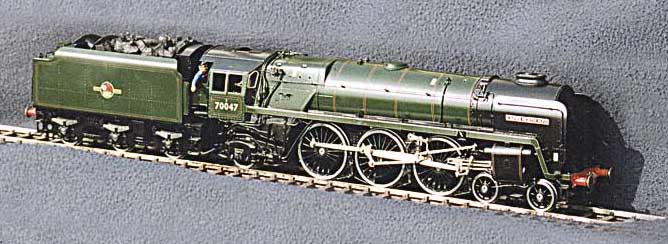
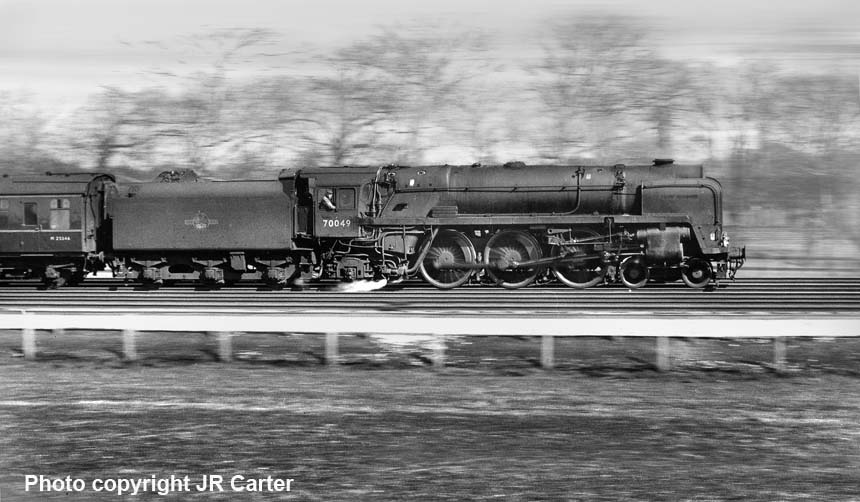
(Above-Below) Not only was Jim the consummate professional railwayman, he was also a master cameraman with an eye for a cracking shot and this panning shot is no exception. Vistors to the site  have often asked who took the photo of 'Britannia' class at the top of the site pages...well, here's your answer. This same loco is referred to in Jim's coal pushing story above - No 70049, minus Solway Firth nameplates - speeds south through Winwick Junction. (Inset( A Solway Firth nameplate measuring 44¾" long, recently went under the hammer for £12,500 at a Great Central Railwyana auction in July 2013. No 70049 was allocated new to Holyhead on 28th July 1954 and had the distinction of being the last steam engine named by BR on 28th May 1960. It was withdrawn from Kingmoor shed in December 1967 and cut up by J McWilliams at Shettleston in March 1968. (Below) Stanier Duchess No 46248 City of Leeds has a substantial payload of 14 bogies whilst heading north at Goldborne between Warrington and Wigan; just visible on the horizon is the former GC St Helens branch the GLC Central line.
have often asked who took the photo of 'Britannia' class at the top of the site pages...well, here's your answer. This same loco is referred to in Jim's coal pushing story above - No 70049, minus Solway Firth nameplates - speeds south through Winwick Junction. (Inset( A Solway Firth nameplate measuring 44¾" long, recently went under the hammer for £12,500 at a Great Central Railwyana auction in July 2013. No 70049 was allocated new to Holyhead on 28th July 1954 and had the distinction of being the last steam engine named by BR on 28th May 1960. It was withdrawn from Kingmoor shed in December 1967 and cut up by J McWilliams at Shettleston in March 1968. (Below) Stanier Duchess No 46248 City of Leeds has a substantial payload of 14 bogies whilst heading north at Goldborne between Warrington and Wigan; just visible on the horizon is the former GC St Helens branch the GLC Central line. 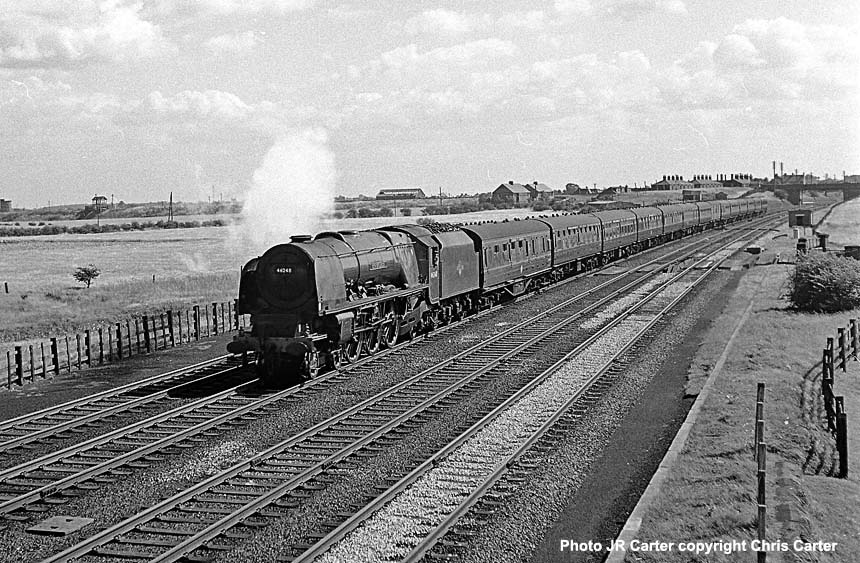
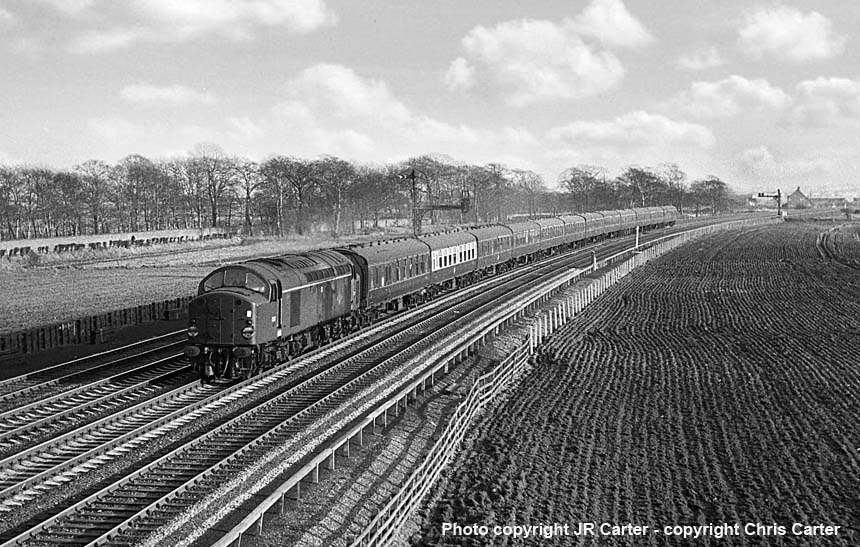
(Above-Below) A classic JRC photo of an unidentified EE Type heading north at Winwick Junction with no fewer than 12 bogies. (Below) The simplicity of the composition makes this shot another classic JRC study (the initial 'R' is for Roy in case you're wondering) and shows 'Britannia' 70033 Charles Dickens heading south at Winwick Junction. Built at Crewe in December 1952, 70033 was delivered new to Holyhead (6J) and remained a London Midland Region locomotive all its life. It spent seven years at Longsight from January 1953, followed by spells at various depots before ending its days at Carlisle Kingmoor prior to withdrawal from traffic in July 1967, a mere fifteen years in service. 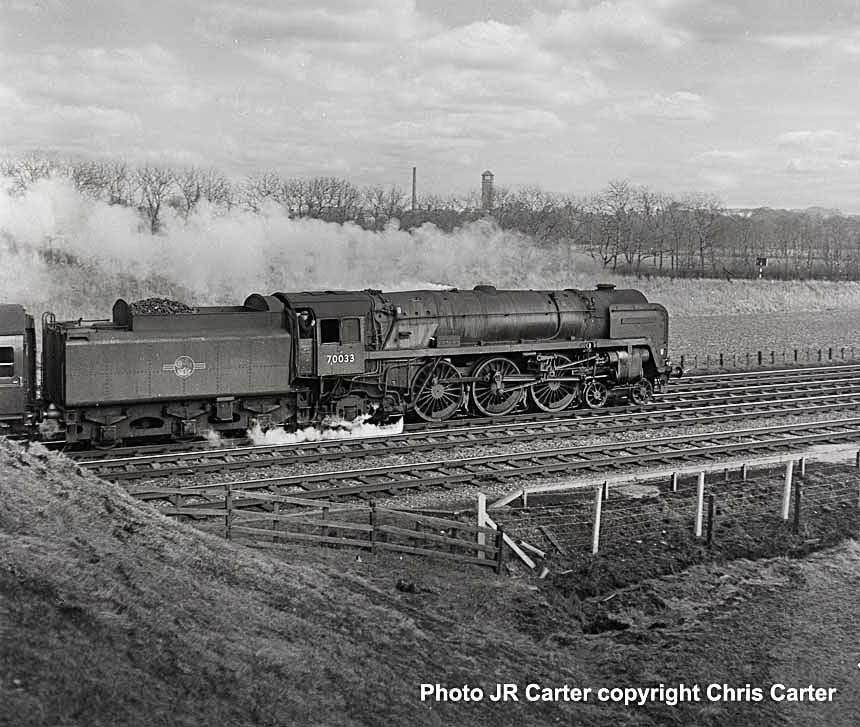

(Above) EE Type No D214 heads a southbound express through Warrington. D214 was later named after the Cunard Line Company's 'Antonia', which dates Jim's photo prior to May 1961. Note the aged lower-quadrant signals in the backgound.
(Left) A locomotive  nameplate, 'Lancastria Cunard Lines' from EE Type 4 1Co-Co1 Class 40 D223, later 40023. New to 5A Crewe North in August 1959, EE/VF works number 267, it was named in May 1961. Withdrawn from Kingmoor Diesel Depot in May 1981, it was cut up at Crewe Works in October 1984. The plate went under the hammer for £8,200 at a Great Central Railwayana Auction in January 2011.
nameplate, 'Lancastria Cunard Lines' from EE Type 4 1Co-Co1 Class 40 D223, later 40023. New to 5A Crewe North in August 1959, EE/VF works number 267, it was named in May 1961. Withdrawn from Kingmoor Diesel Depot in May 1981, it was cut up at Crewe Works in October 1984. The plate went under the hammer for £8,200 at a Great Central Railwayana Auction in January 2011.
The LMR's decision to name its initial allocation of EE Type 4s was a commendable policy; the names selected came from the ocean liners belonging to the Elder Dempster, Canadian Pacific Steamships, and Cunard shipping companies which sailed into the Port of Liverpool.
The first three members of the class, Nos D210 Empress of Britain (Canadian Pacific Steamships), D211 Mauretania (Cunard Lines) and D212 Aureal (Elder Dempster Lines) were named during ceremonies early in 1960, whereas the remaining twenty two locos Nos D213-D225 and D227-D235 - had their nameplates fitted during works overhauls at Crewe.
Mention of the various ships that sailed in and out of the Port of Liverpool reminds me of a story  that I just know would have tickled dad's impish sense of humour....
that I just know would have tickled dad's impish sense of humour....
A young Birkenhead woman was so depressed that she decided to throw herself off Runcorn Bridge. She was about to leap into the icy water when a handsome young sailor saw her tottering on the parapet. He took pity on her and said - 'Look, you have so much to live for. I'm sailing to America in the morning, and if you like, I can have you stowed away aboard my ship. I'll take good care of you and bring you food every day...'
The girl nodded, 'Yes, why not? After all, what do I have to lose? Perhaps a fresh start in America will give my life new meaning.'
That night, the sailor smuggled her aboard and hid her in a lifeboat, then every night he brought her food and they made passionate love until dawn.
Three weeks later, during a routine inspection, she was discovered by the captain, 'What are doing here?' he asked.
'I have an arrangement with one of the sailors who has stowed me aboard,' she explained - 'I get food and free passage to America...'
'America!' said the captain in astonishment - 'But this is the Mersey Ferry, my dear...'
(Below) The wild, swindsept moor of Shap Fell is captured perfectly in Jim's shot of D224 (named after the Cunard Line's 'Luciana' in August 1962). The 2,000hp Type 4 does battle with 1 in 75 climb to the summit at Greenholme box. 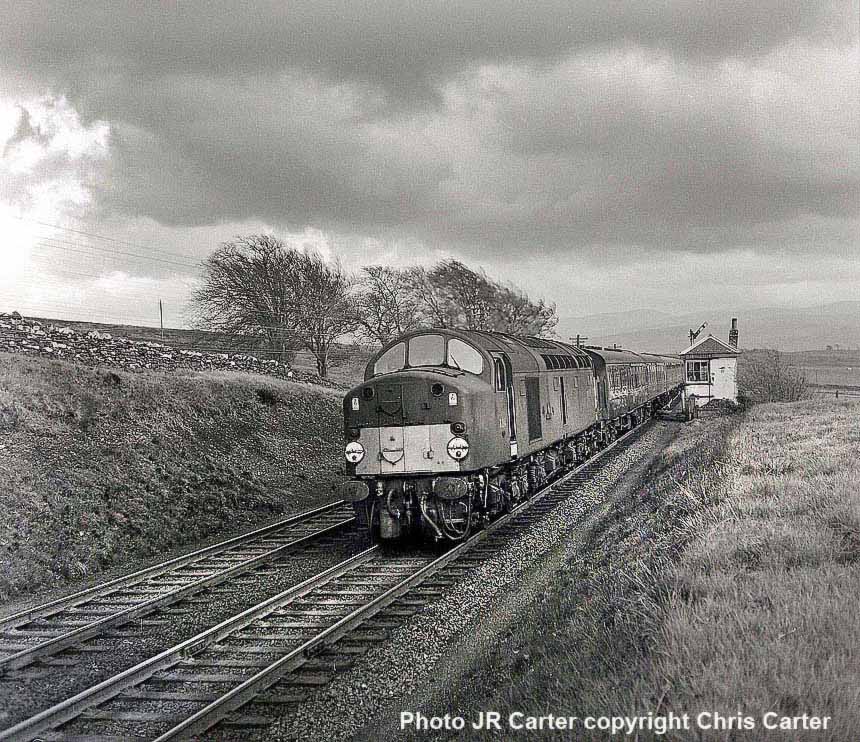
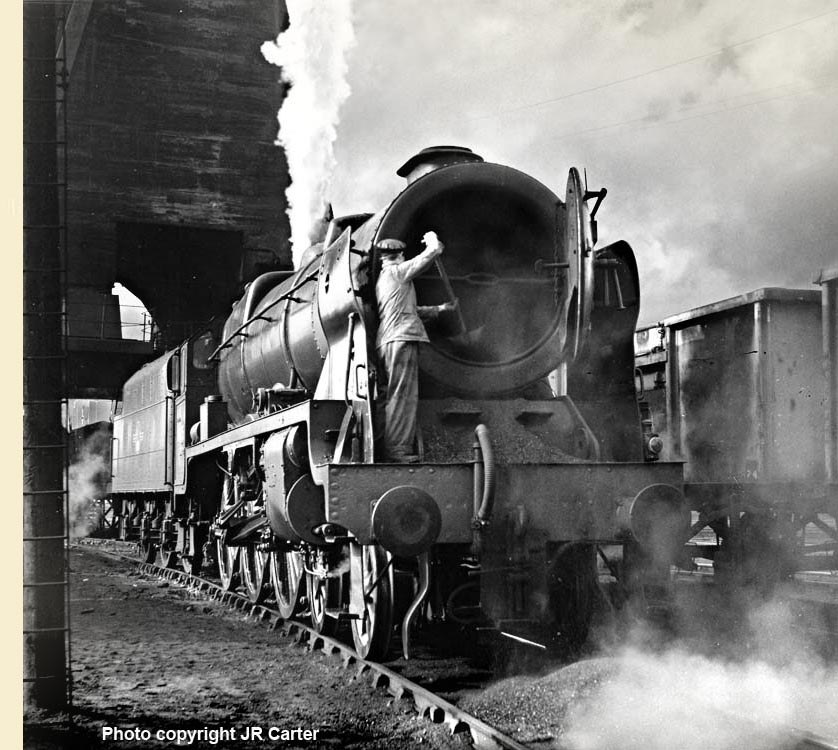 (Inset Right) A lousy job, but somebody had to do it! The ash got everywhere...down your back, up your nose...in your boots. Scot class 46152 The Kings Dragoon Guardsman has a good pile of residual ash removed from the smokebox.
(Inset Right) A lousy job, but somebody had to do it! The ash got everywhere...down your back, up your nose...in your boots. Scot class 46152 The Kings Dragoon Guardsman has a good pile of residual ash removed from the smokebox.
Listening to dad talking about steam days, he told me that one of the less agreeable turns was the disposal link when a driver and his mate would be required to dispose of six engines each shift. This was often a race against time as engines arrived on the shed with the fire run down and pressure falling, and the situation worsened when the smokebox was opened and cold air hit the front tube plate.
The first job was to put the bag in and get a full tank of water before going under the coal chute to top up the tender. Once this had been done the loco was drawn up to the ash pit, the smokebox opened and the residual ash removed. If you got one with the paintwork scorched, usually 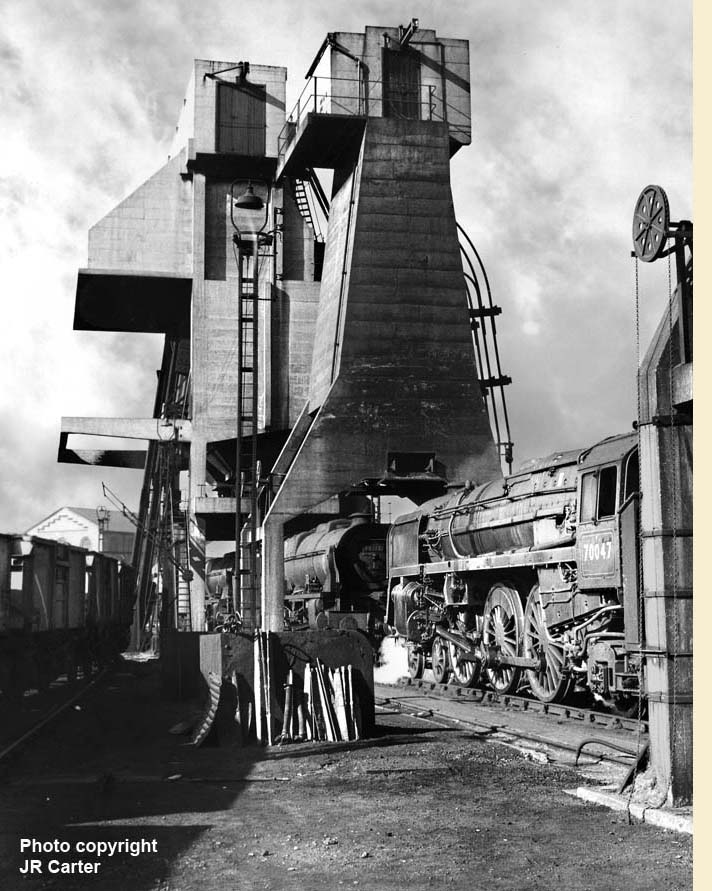 a high-mileage engine, you knew it was going to be bad, especially if it was windy; the ash got everywhere; it got down your back, up your nose, in your boots - you even ended up chewing it!
a high-mileage engine, you knew it was going to be bad, especially if it was windy; the ash got everywhere; it got down your back, up your nose, in your boots - you even ended up chewing it!
Once the smokebox was clear, the loco was then driven onto the ash pit where the fire could be graded, and the clean fire pushed to one side of the box. An opening was then made in the grate. This was done by removing fire-bars with tongues and dragging the bars up into the cab through the firebox door. The ash and clinker was then pushed through the gap into the ashpan by use of a 'paddle'.
Then it was under the engine and into the pit, to open the front and rear dampers and rake out the ashpan. I was always pleased when we had to dispose of locos with rocking grates and self cleaning smokeboxes as they could be dealt in about twenty minutes...
(Inset Left) The solitary unnamed 'Britannia' Class 7MT No 70047 and 'Scot' class 46127 Old Contemptibles at Crewe South shed (5B).
(Above) During the changeover from steam to diesel traction the enterprising English Electric Company was the only manufacturer to have designed and built diesel locomotives to meet the requirements of all five (Type 1-5) BR diesel power classes. The company also supplied more than half of the diesel fleet. During his time at Patricroft Jim was fortuitously placed to photograph deliveries of the new locos from the EE works at Newton-le-Willows to Doncaster, several of which appear on the first 'Diesel Cameraman' page. Here EE Type 4 D281 is held at signals at Manchester Exchange during delivery to Doncaster Plant for acceptance trials in January 1961. Allocated new to the North Eastern Region D281 (later TOPS Class 40081) was withdrawn from traffic in February 1983, having served a little over 22 years of service.
(Below) Having abandoned the BTC's 1955 pilot scheme, in which large orders were placed predominantly for Type 2 diesel locos of between 1,000 and 1,365 engine horsepower, BR recognized the need for a more powerful Type 3 of around 1,750hp mounted on a Co-Co wheelbase. By this time the English Electric Co had delivered a number of successful diesel and electric loco types both for BR and the export market, therefore the BTC awarded the Type 3 contract to the company in 1959. From the outset the new Type 3 fleet incorporated many tried and tested components such as the engine, generator, traction motors and control gear, thus allowing faster production and lower costs. Powered by the EE Co's 12-cylinder 12CSVT engine, the new Type 3 was essentially a scaled-down version (using a shortened bodyshell) of the D200s introduced on the Eastern Region in 1957, and since the ER was already familiar with the company's pedigree, the operating department was quick to employ the new mixed-traffic Type 3s on the Liverpool St-Cambridge-Kings Lynn passenger services. Here newly-built D6706 (Works No 2869/D585) approaches Manchester Exchange on its way to Doncaster on January 20th 1961. The loco was allocated to Norwich Thorpe (32A) and six months later transferred to Stratford (30A).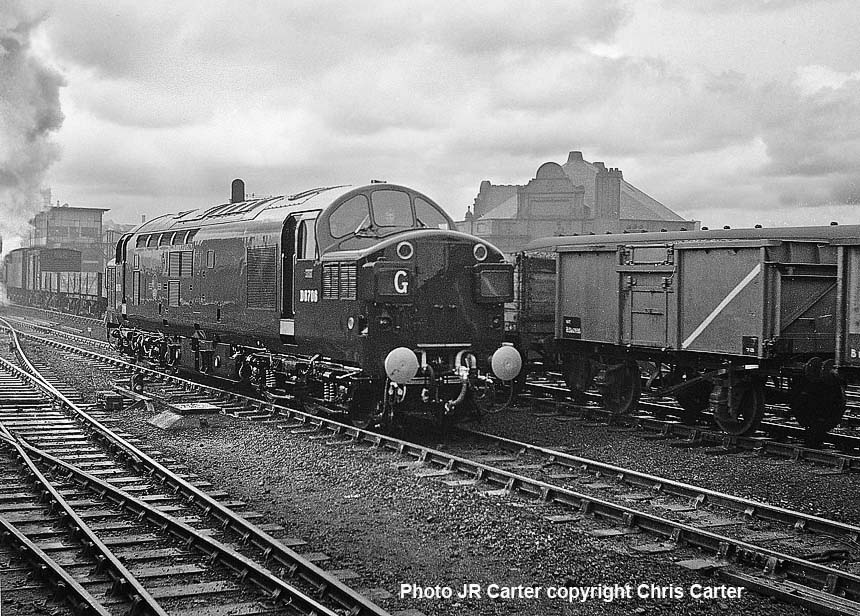
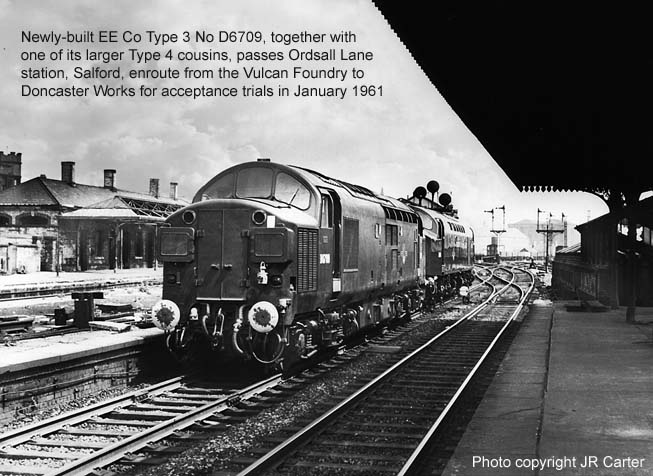
(Above) The English Electric Co's desire to standardise wherever possible meant that many components of the Type 3 superstructure and various other fitments were in common with the Type 4, and externally the D6700s differed very little from their earlier D200 cousins. After initial operating experience with the English Electric Type 3's Co-Co wheelbase, the response by the operating department was unanimously favourable, particularly as the locos had sufficient power to take on many duties performed by the more powerful 1Co-Co1 Type 4s. Here newly-built D6709 (Works No 2872/D588) passes through Arsdley Road Station behind its larger Type 4 cousin on 17th February 1961. Allocated new to Stratford (30A) No D6709 (later TOPS Class 37009 and 37340) has enjoyed a long career, for after the disbandment of BR in 2001 she was sold by English, Welsh and Scottish Railway (EWS) to Direct Rail Services. Today she has found a new lease of life in preservation with plans for a return to traffic in BR Green livery with full yellow ends.
(Below) The first six NBL Co's Type 2 B-B diesel-hydraulic locos Nos D6300-D6305 (later Class 22) were ordered as part of the BTC's pilot-scheme. The delivery of the five to the WR began in 1958 and featured the same engine as the NBL's diesel electric machines (later Class 21) which were intended for the Eastern Region. As happened with many of the BTC's pilot-scheme locos, an order for 52 more machines was placed even before the first, No D6300, had been built. The Type 2 was designed to be used singly for secondary work or coupled in multiple for heavier duties, which entailed the fitting of gangway connections in the nose ends. However, the NBL/MAN engine of the additional locos were uprated to 1,100hp in order to correspond with the NBL-built D800 Warship class then being built, thus providing further flexibility in multiple working and future engine changes between both classes. The entire Class 21 was later fitted with four character headcode boxes on either side of the centre gangway door. Here newly-built D6324 heads through Wigan in June 1960. 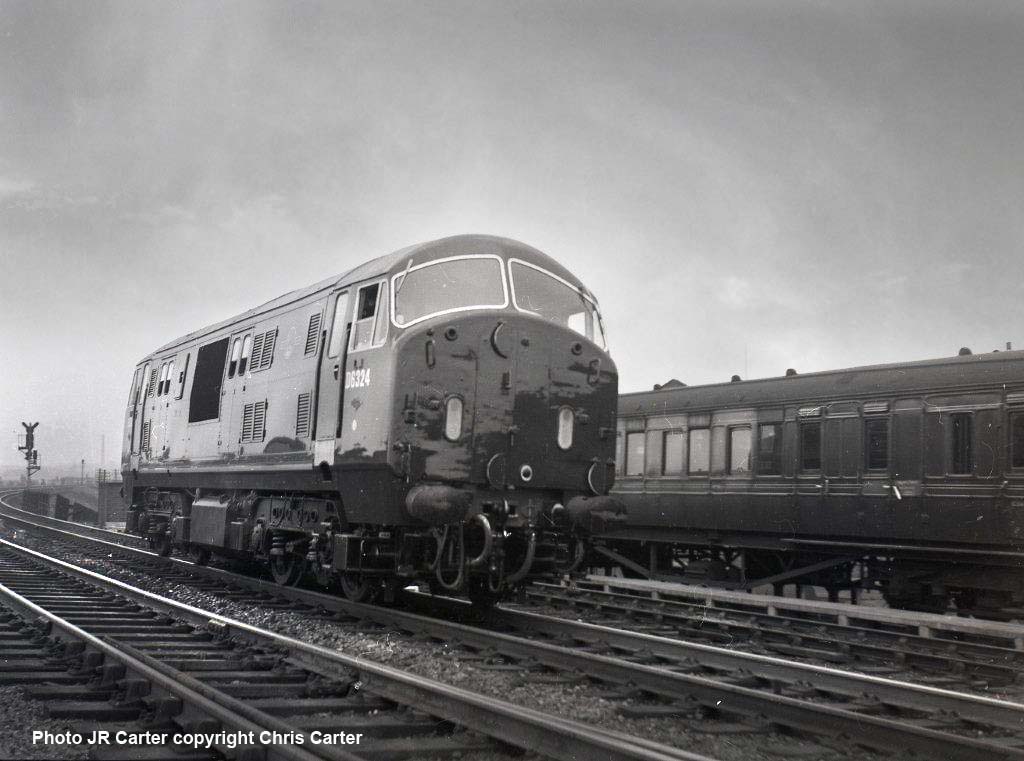

(Above) One of the anomalies of dating old railway photographs is that important details can become lost in the mists of time, and Jim's photo of newly-built NBL Co's Type 4 diesel-hydraulic 'Warship' enroute from the company's Glasgow Works to the Western region is a case in point. No D855 Triumph is seen heading south through Wigan with its Type 2 cousin No D6324 in tow. It wasn't until Chris unearthed the previous photo of newly-built D6324 that details of this shot become clear. I am reliably informed by Martin Sheen that No D6324 had suffered collision damage on 30th January 1961 and was sent from Laira to the NBL works at Glasgow for repairs. The loco returned to Swindon along with newly-built D855, arriving at Swindon on 13th October 1961. It returned to traffic on 23rd October, whereas D855 began revenue-earning service on the 16th, therefore we can surmise that Jim's photo was taken on either Thursday 12th October or Friday the 13th.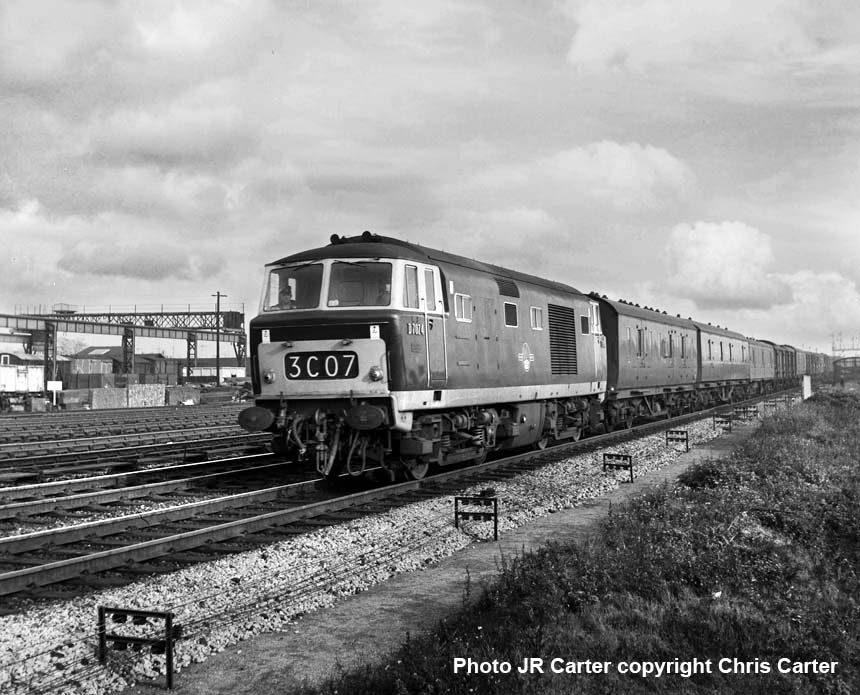
(Above) 1959 also heralded the dawning of the 'Hymek' era on the Western Region. When the BTC abandoned the pilot scheme plan, several orders were placed with manufacturers for diesel-hydraulic traction before the new designs had been fully evaluated in service conditions. As a consequence, a total of 45 'Hymek' B-B Type 3 diesel-hydraulic locos were ordered from the Beyer Peacock Works at Gorton without a single prototype being constructed. The first 1,700hp Type 3 was handed over to the Western Rgion at a ceremony held at Paddington on May 16th 1961. The two-tone green livery, white window surround and raised metal cabside number show up well on D7074 heading the 3C07 at an unknown location.
Mystery solved! My thanks to Roger Gardner BA (Hons) who writes - 'As an ex railwayman based in Reading, I would just like to point out that Jim carter's picture of a Hymek working 3C07 is just west of Reading station on the down slow. I would guess that Jim Carter had walked across to the lineside from the depot which is out of view on the right of the picture. Hope this helps. Regards Roger.'
(Below) D7042 heads the 1C31 at an unknown location...if anyone knows the whereabouts of the two Hymek photos I would dearly love to hear from them.
Another mystery solved! Paul Fishwick has left a comment on the Guest Book Page - 'The height shot of D7042 is Reading West. I stand to be corrected but I think so…'
That's good enough for me, until anyone say any different - Reading West it is! Thanks Paul.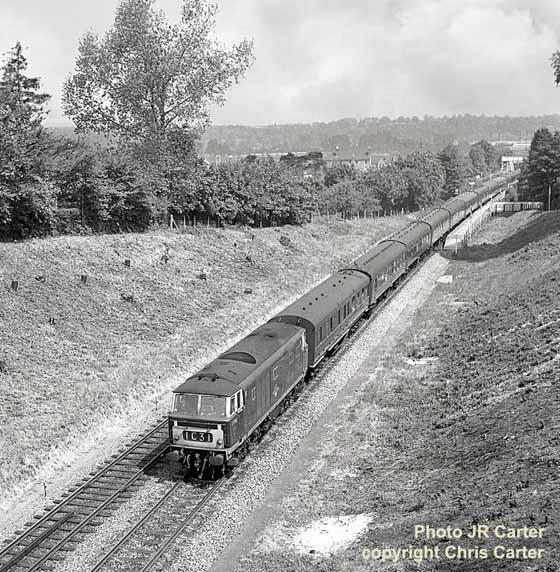

(Above-Below) The 'Western' class C-Cs were yet yet another type introduced without the benefit of full prototype trials, yet no fewer than 74 locomotives were ordered - 35 to be built at Swindon and 39 at Crewe, but as it turned out, Crewe also constructed the last five of Swindon's allocation. Still in workshop primer, 'Westerns' Nos D1055 Western Advocate and D1056 Western Sultan are shunted into the paintshop yard at Crewe by Class 3F No 47597. (Below) Before the British Rail Board imposed its dull overall blue livery on locomotives (my personal view) the stylish Westerns appeared in shades of green, chromatic blue, golden ochre and maroon. The class was designed by Swindon to fulfil the WR operating department's need for a more powerful Type 4 than the lightweight 2,200hp B-B D800 'Warships' which struggled with the heavier WR trains and required assistance over the south Devon banks of Dainton, Hemmerdon and Rattery between Newton Abbott and Plymouth. At 2,700hp, the C-C Westerns were powerful enough to handle the heaviest trains single-handed throughout. Following an overhaul at crewe Works No D1018 Western Buccaneer was photographed at Chester on a running-in turn...beneath the photo is a shot of Crewe-built D1042 Western Princess passings signals at an unknown location. If anyone knows where I'd dearly love to hear from them.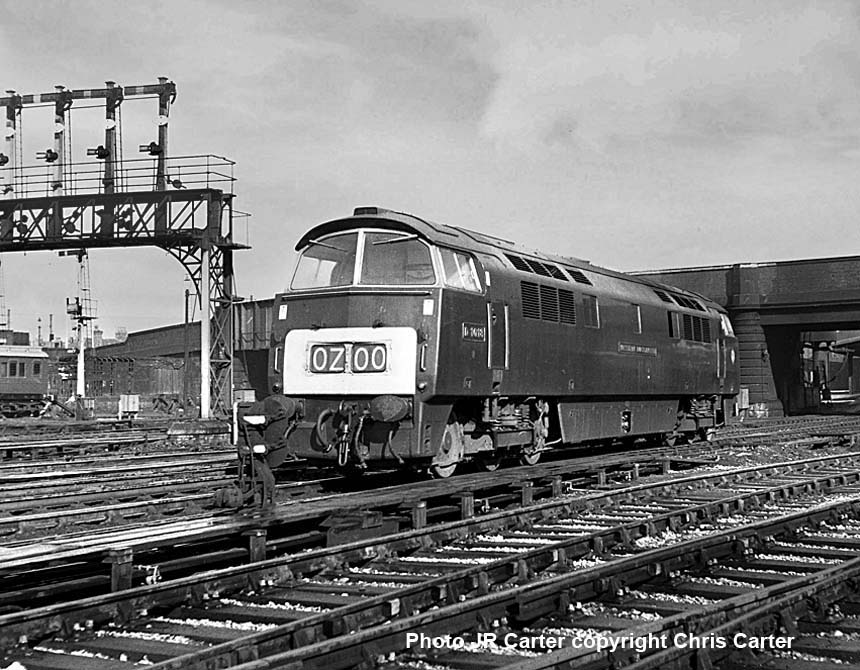
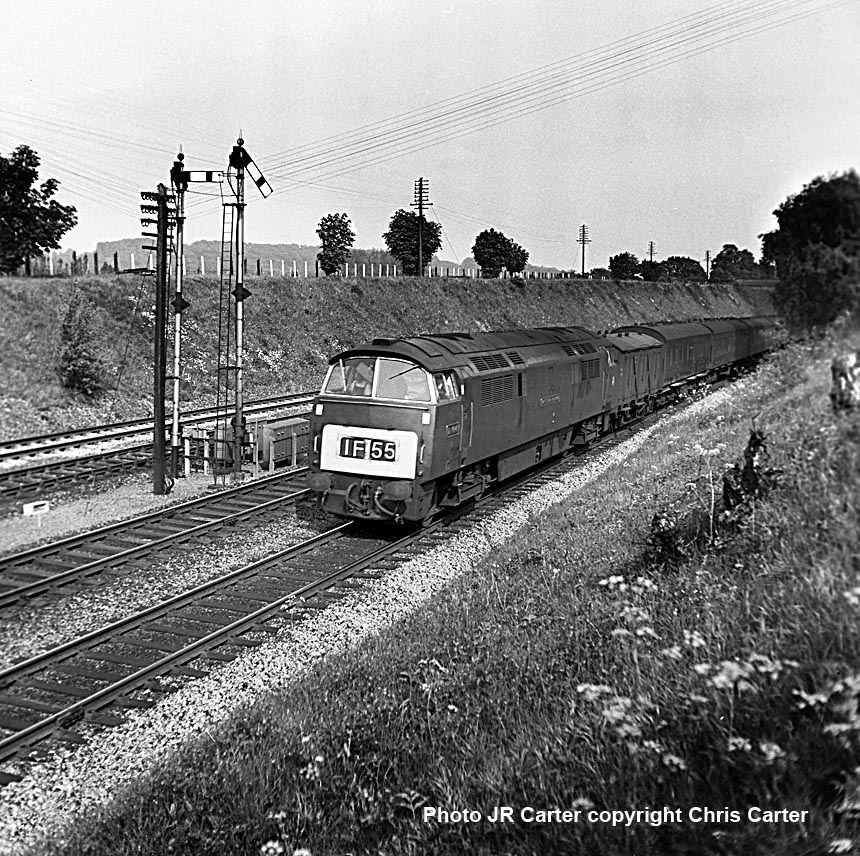
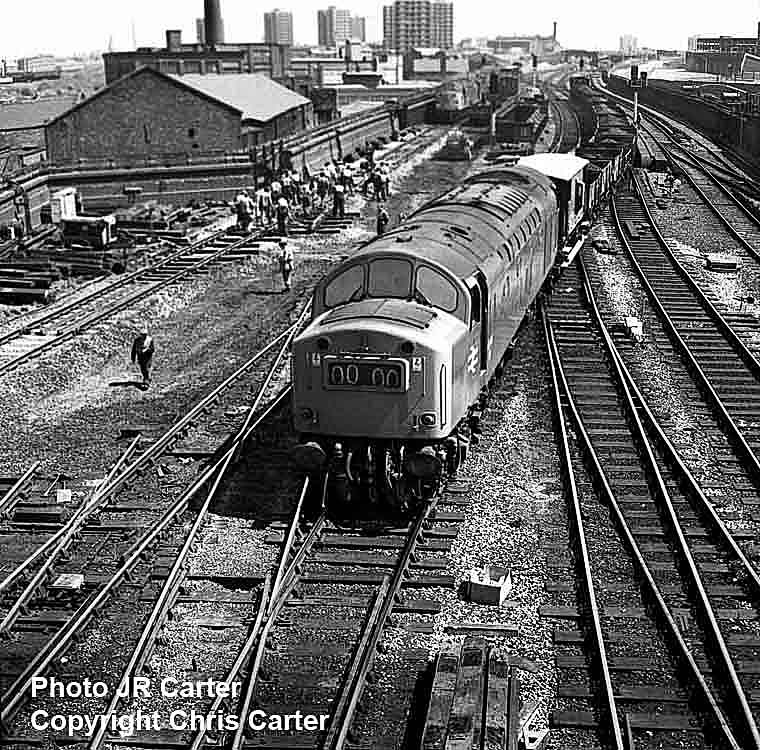
(Above-and remaing shots below) We are now well into the 1980's BR period, long after the British Rail Board (BRB) was formed, and the diesel fleet has acquired an overall blue livery and full yellow nose ends (as stipulated by the BRB's Accident Prevention Service). At the same time the four-character headcode train identification scheme was abandoned. The varying non-descriptive digits that appeared in the headcode panels was a major factor for BR's decision to get rid of them. From 1976, BR decreed that operating handles were to be removed and blinds set permanently at '0000'. Following classified overhauls at BR works the distinctive four-character headcode boxes were removed completely and two fixed-beam lamps were fitted on the nose, yet the earlier locomotives (fitted with the aged headcode discs from steam days) continued to display some form of train identification, though not necessarily the right one! Here we a selction of photos showing diesels at work in and around Jim's old stamping ground of Manchester. 
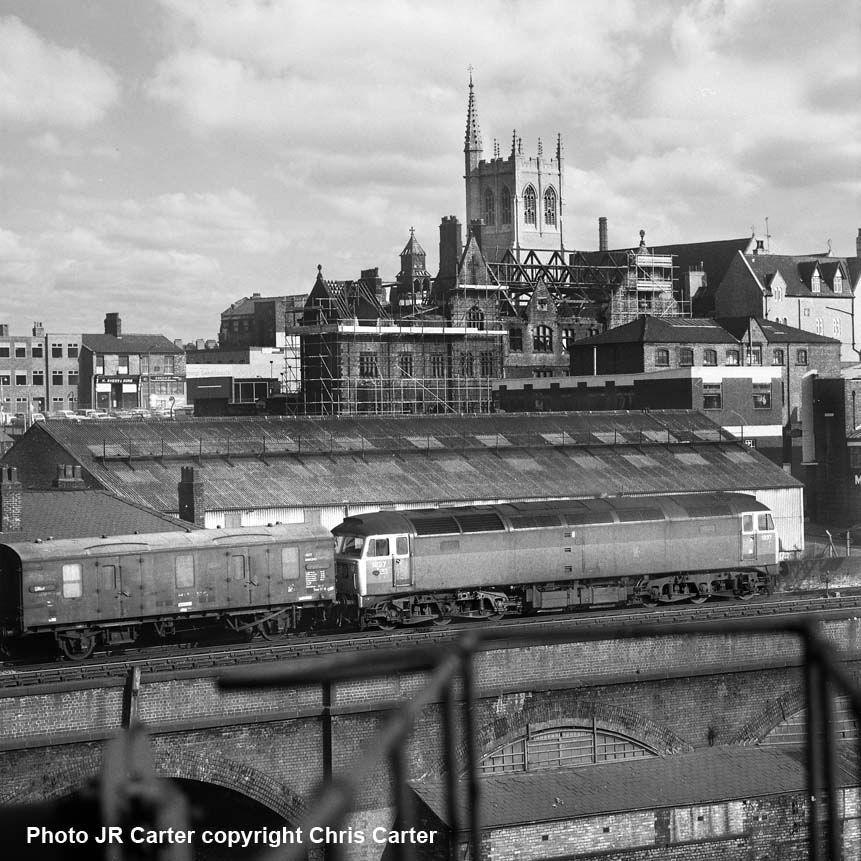

As we reach the end of this second tribute page, I must mention that after dad had completed his two years National service he returned to Widnes Depot for a short spell, but decided it was time for a move. Not surprisingly his first choice was Crewe North shed, but at the time there were no vacancies for a grade to grade move...it was a massive setback for him. But any disappointment was amply compensated for when he moved to Patricroft Loco in March 1959, and in August 1962 he became a passed fireman which meant that he could be called upon to drive steam locomotives.
He clearly remembered his first driving turn, which was to take a Horwich 'Crab No 42710 light engine from Patricroft to Springs Branch Shed at Wigan and a few weeks later at the tender age of 25 years he was driving Rebuilt 'Patriot' No 45527 Southport with 11 bogies of the 17.00 Manchester-Newcastle express over the Standedge route.
I was born some six years later in June 1968, just 12 days before Patricroft depot closed. Not only did I miss dad's steam years...but I also missed the end of BR steam in its entirety in August 1968. However, just being invited by dad to join him on his subsequent trips to the lineside to photograph diesels left an indelible impression on me...
I have left this picture (below) until last because I wanted to finish the tribute page with a classic photograph. It is my favourite picture of all dad's early diesel shots, not just because it is a Deltic but because it is just so atmospheric; absolutely wonderful. I can almost hear the roar of the hard working Napier engines as D9011 The Royal Northumberland Regiment storms out of Leeds Central with a train for Kings Cross; it is just the stuff of my dreams.
This is a personal dedication not only to my dad but to my best friend and the biggest inspirations in my life. Thanks for the memories dad (Jim the Steam). 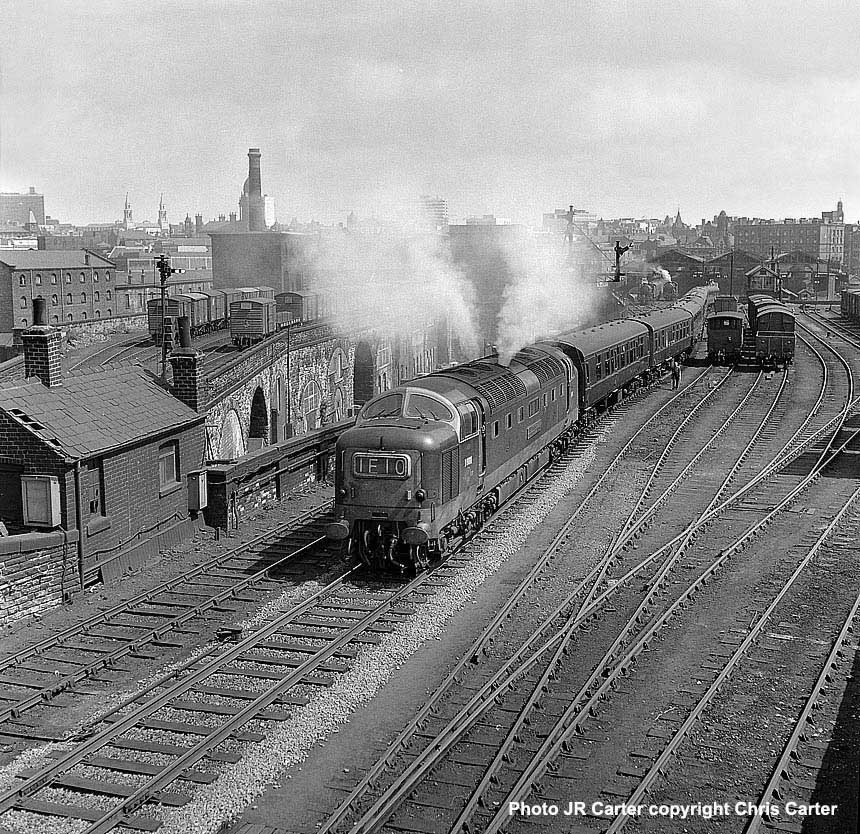

Special thanks also go to Geoff Burch (engineman, rail cameraman, author) - Andy Sparks (rail cameraman, author and Editor Whistler magazine) and John Stephens (CFPS Chairman), without whose help these tribute pages would not have been possible. This has meant so much to me, because what started out as just a tiny seed of an idea has now become a reality...and special thanks must go to David Hey who has been a true inspiration.
Thank you all...
Chris Carter
GREAT NEWS! CHRIS HAS LAUNCHED HIS OWN WEBSITE DEDICATED TO HIS DAD
CLICK ON IMAGE BELOW
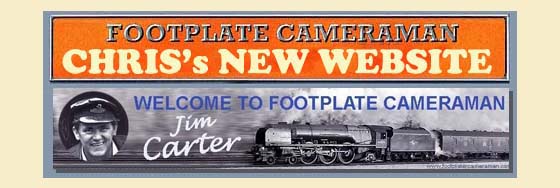
 | 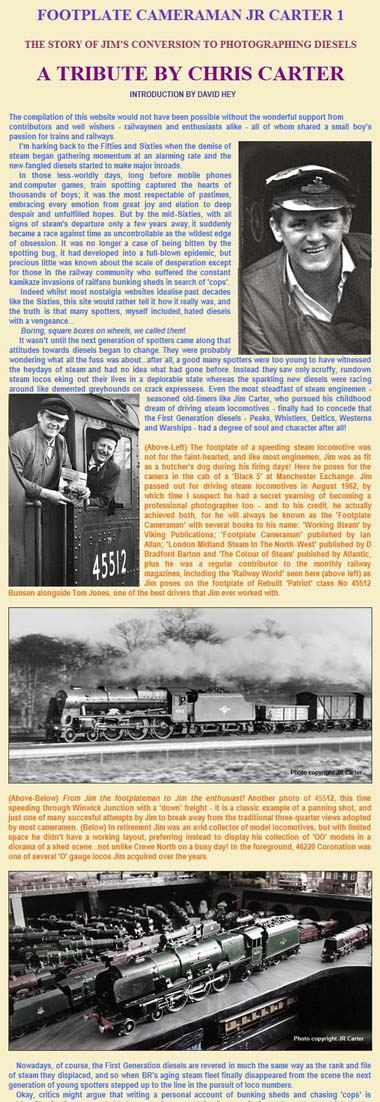 |
NOW THAT YOU HAVE A MEASURE OF JIM, WHY NOT VISIT HIS ORIGINAL 'RAIL CAMERMAN' PAGE (above left) AND CHRIS CARTER'S FIRST 'DIESEL CAMERMAN' PAGE IN TRIBUTE TO HIS DAD (above right). CLICK ON LINKS ABOVE...
Polite notice: All text and photographs are protected by copyright and reproduction is prohibited without the prior consent of the © owners. If you wish to discuss using the contents of this page the email address is below. Please note - this is not a 'clickable' mail-to link via Outlook Express. You will have to email manually.
dheycollection@ntlworld.com
chris68@blueyonder.co.uk
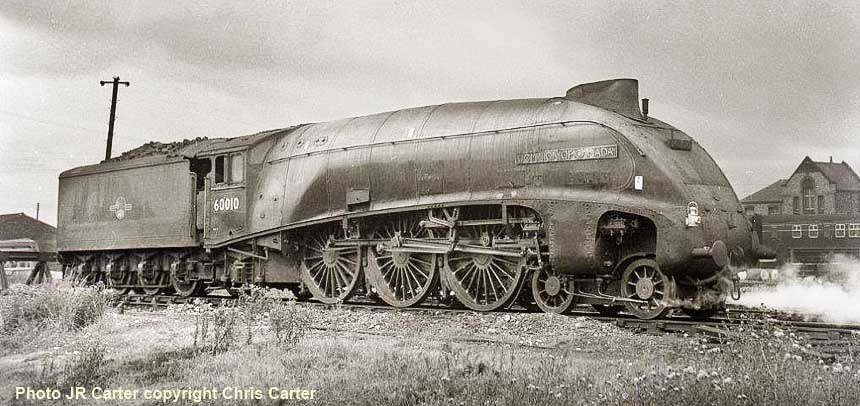
Ever since Jim's railway photos first appeared on this site, a lot of people have expressed interest in his work. A number of Jim's railway photographs are now available from www.rail-online.co.uk. This on-line railway photographic library is well worth a visit. Over the next few months more than a thousand of Jim's photos will be added. Click here to visit the site. Please note I am not affiliated with the sale of Jim's photos in any way, merely passing on a contact address




